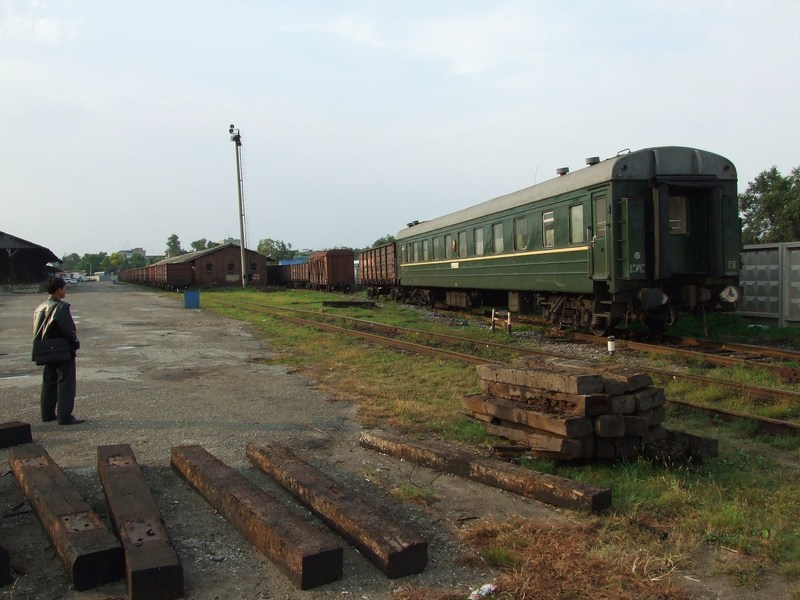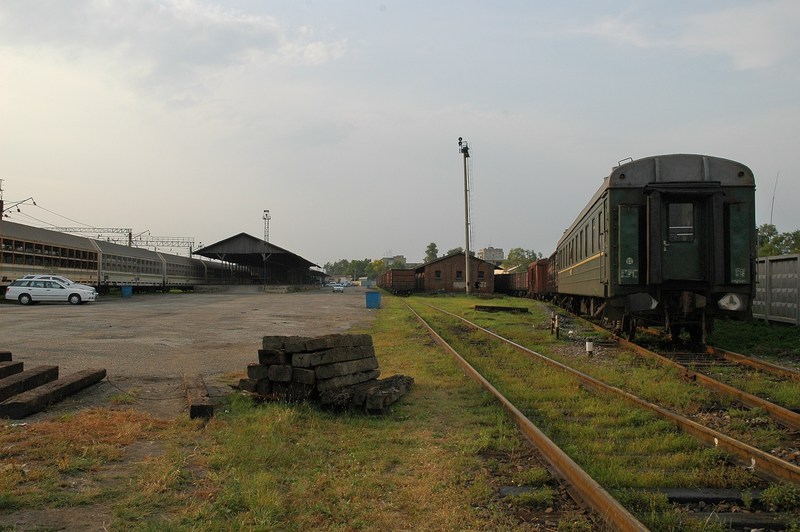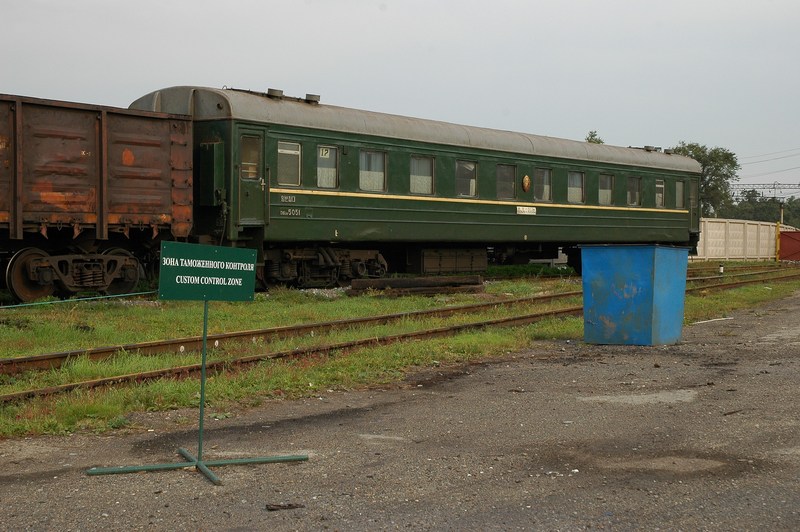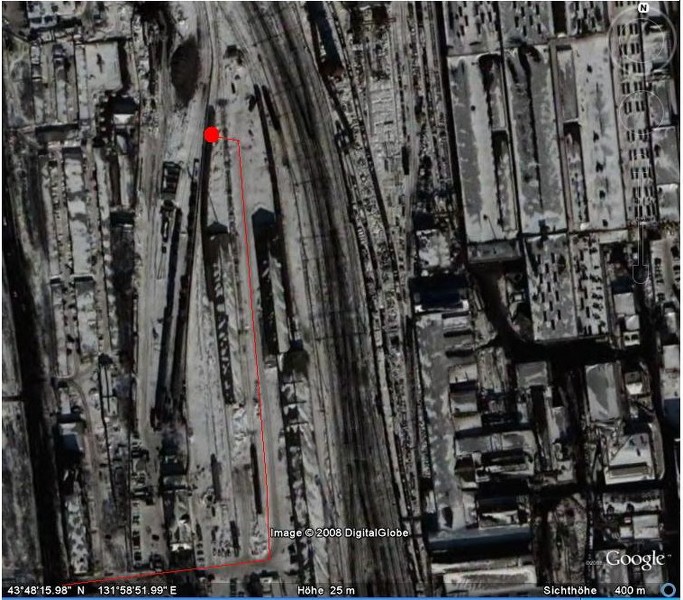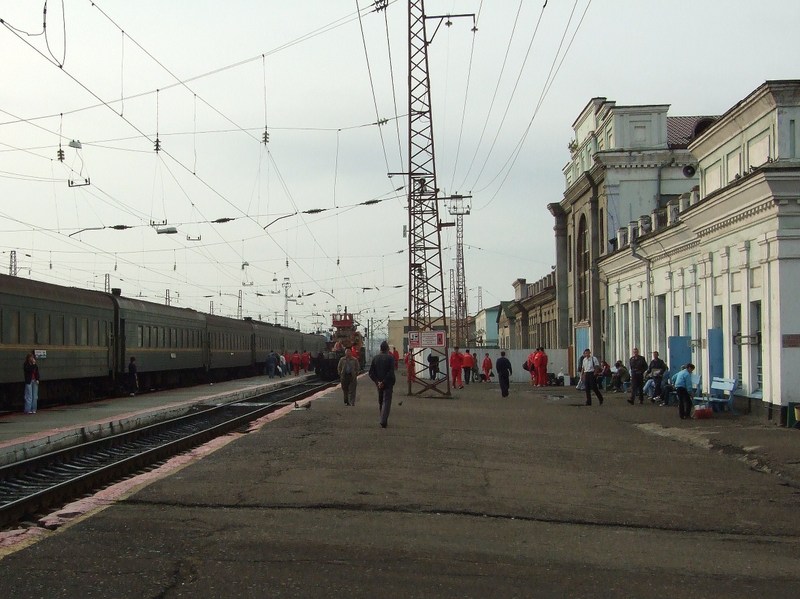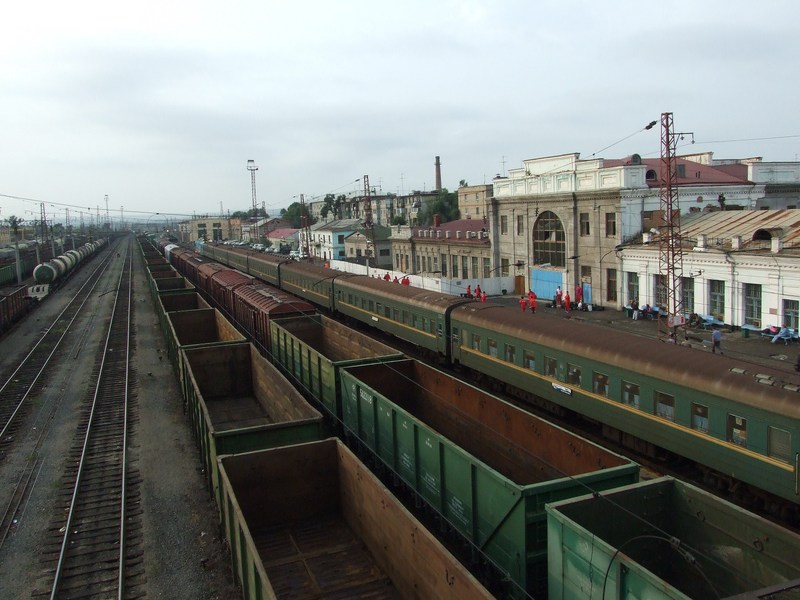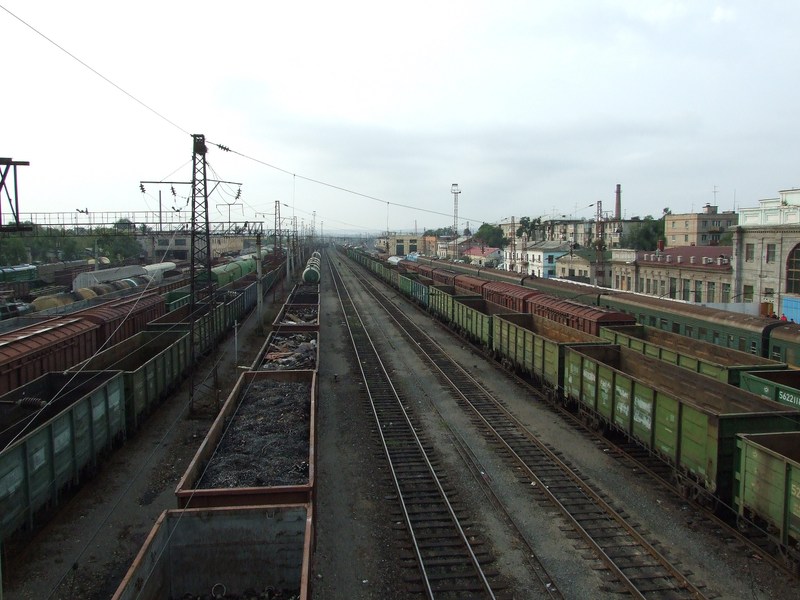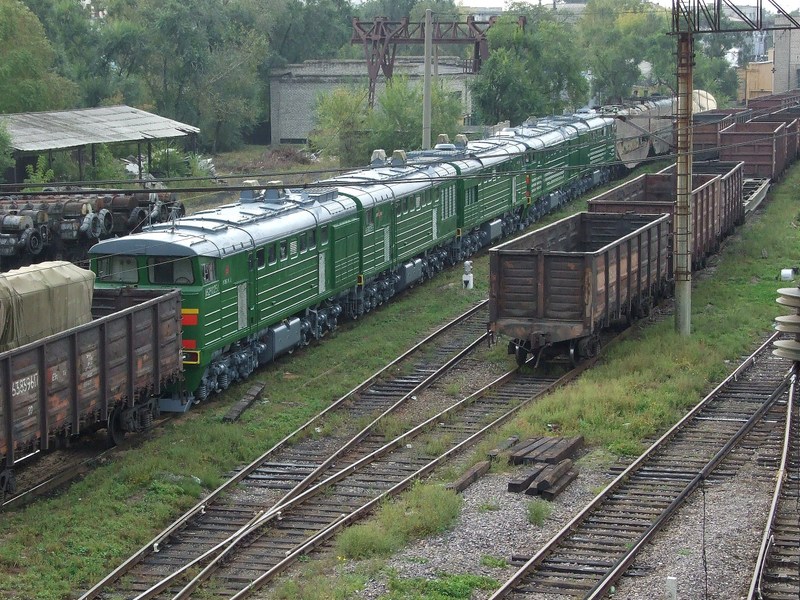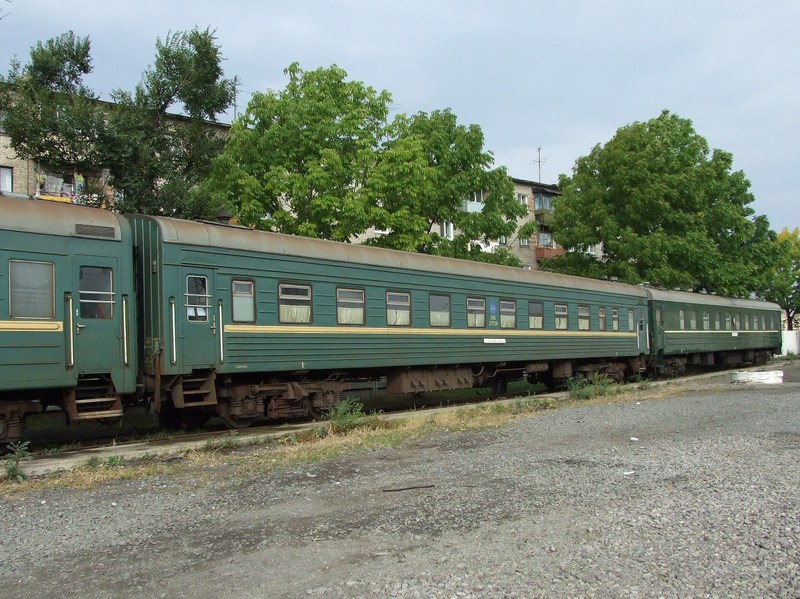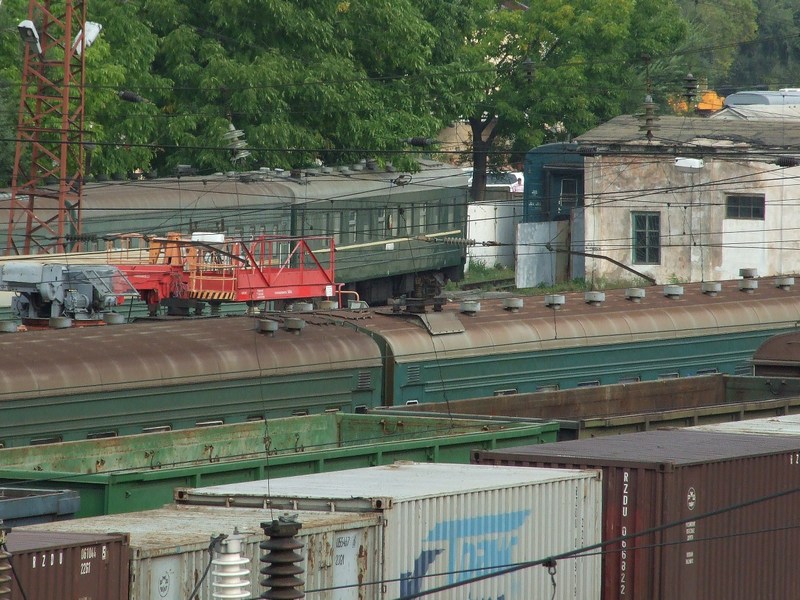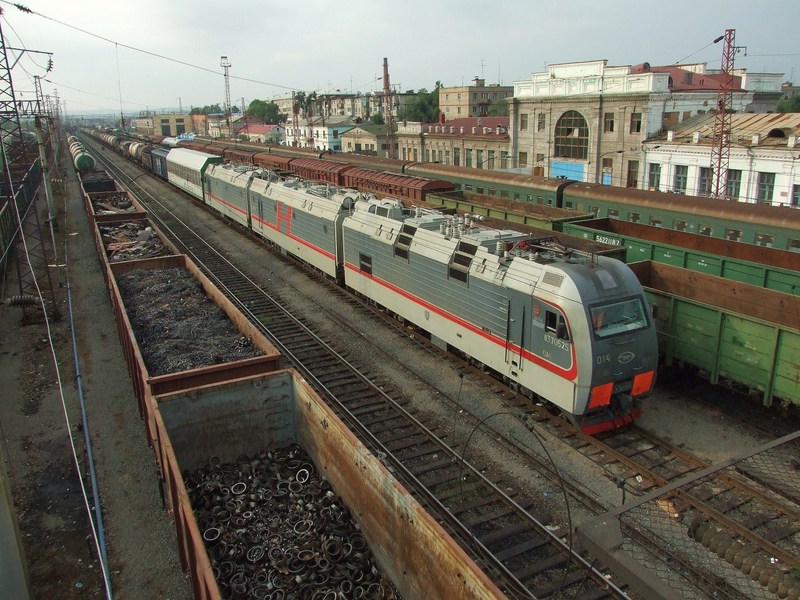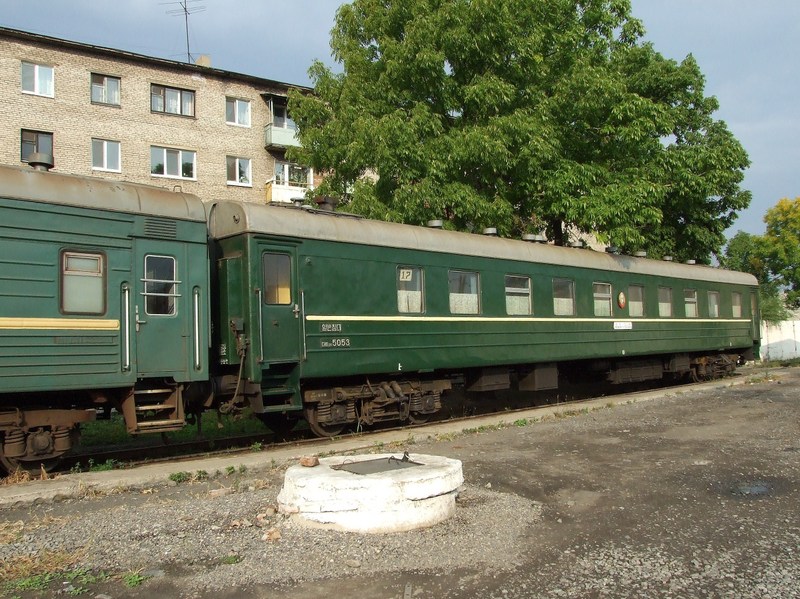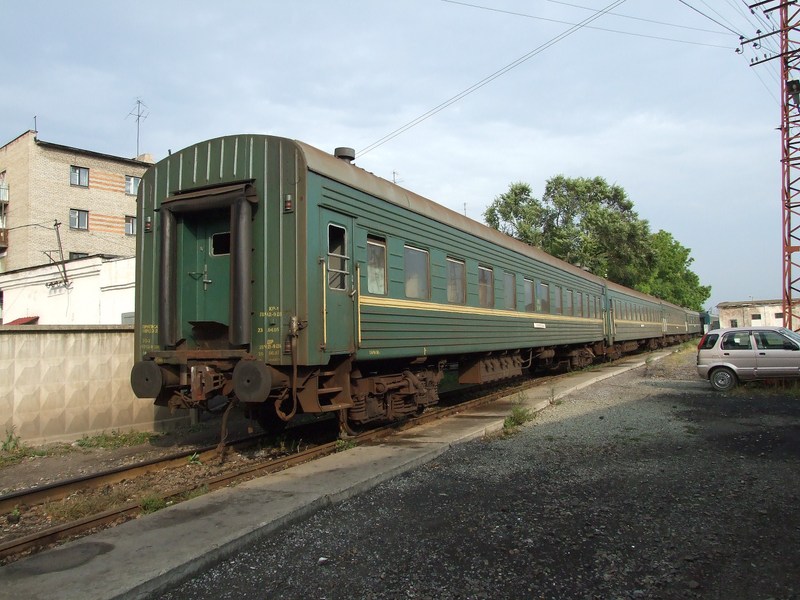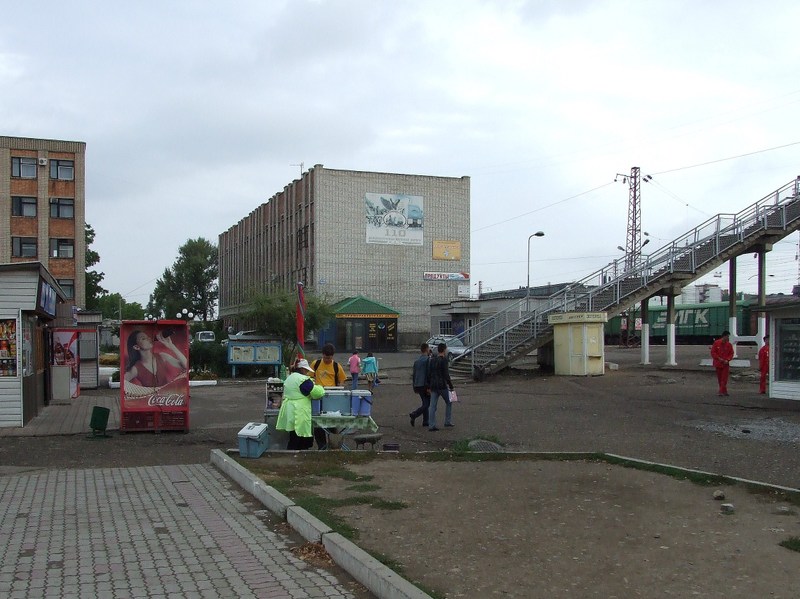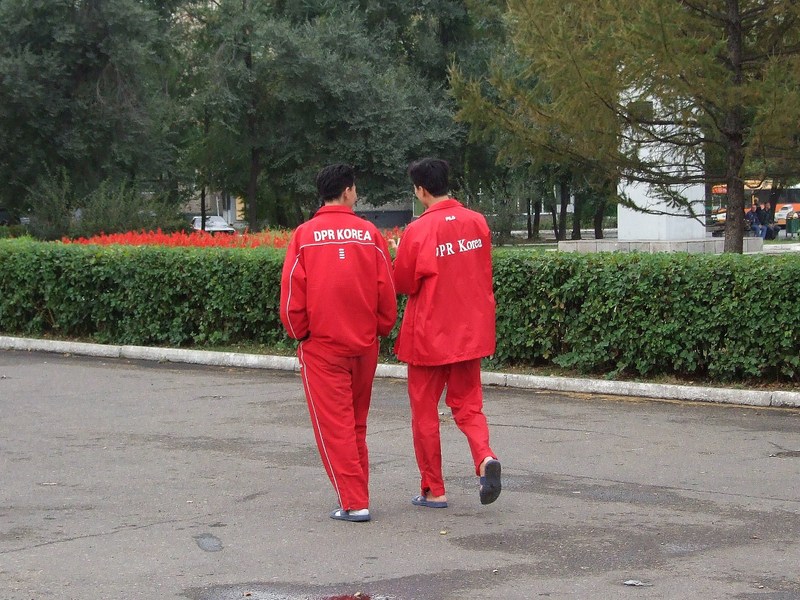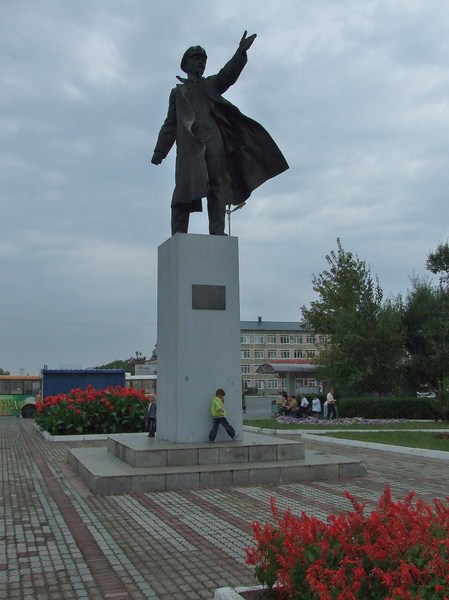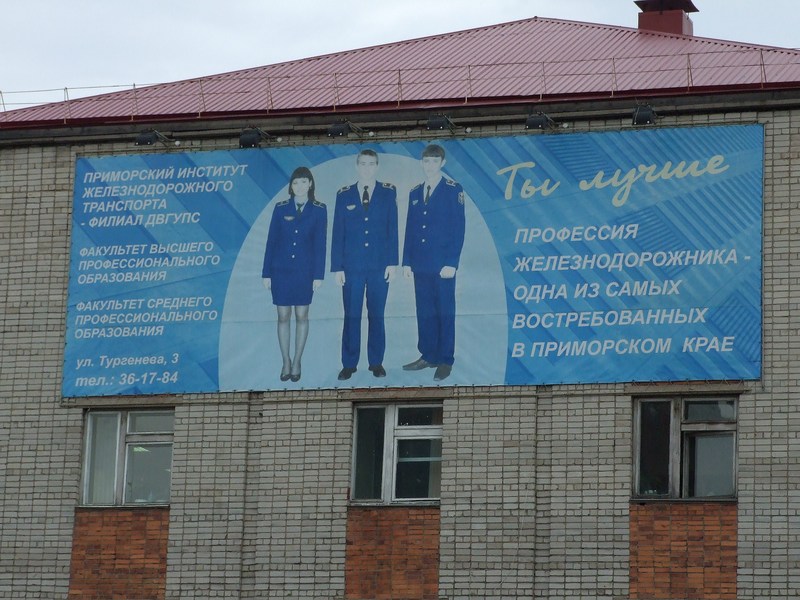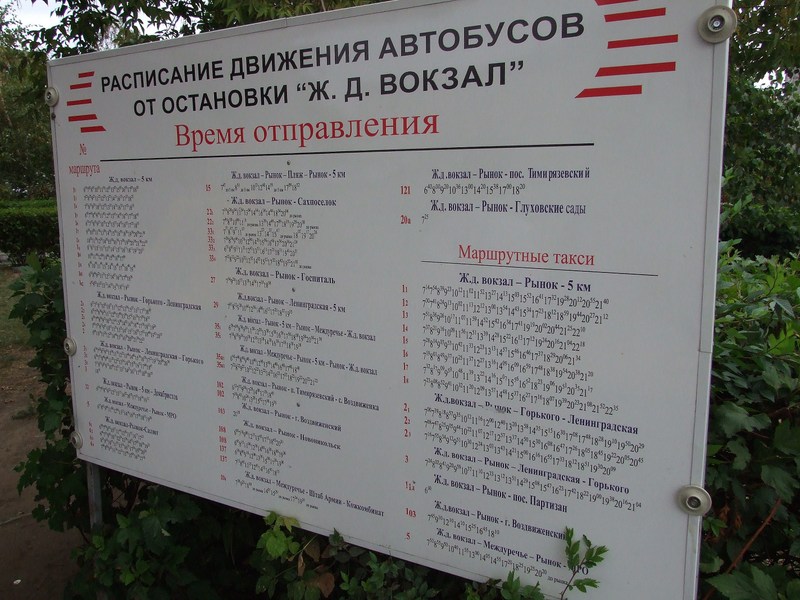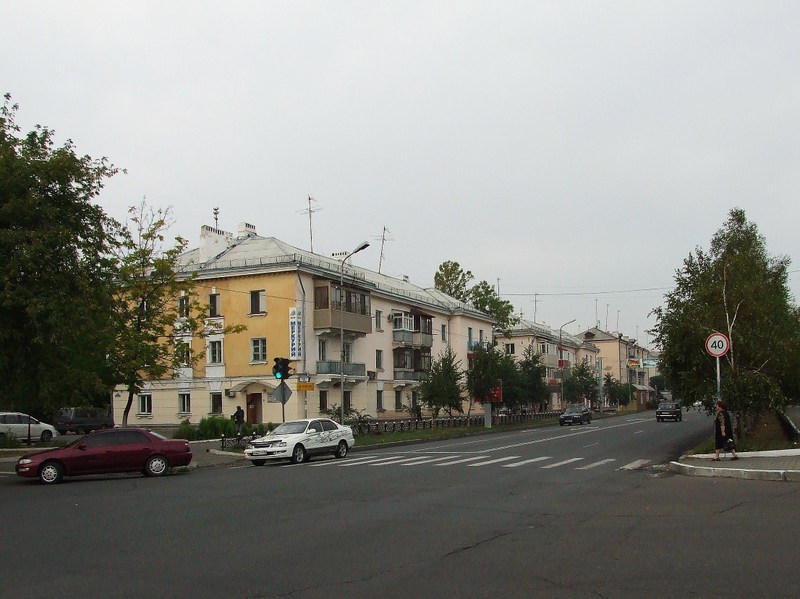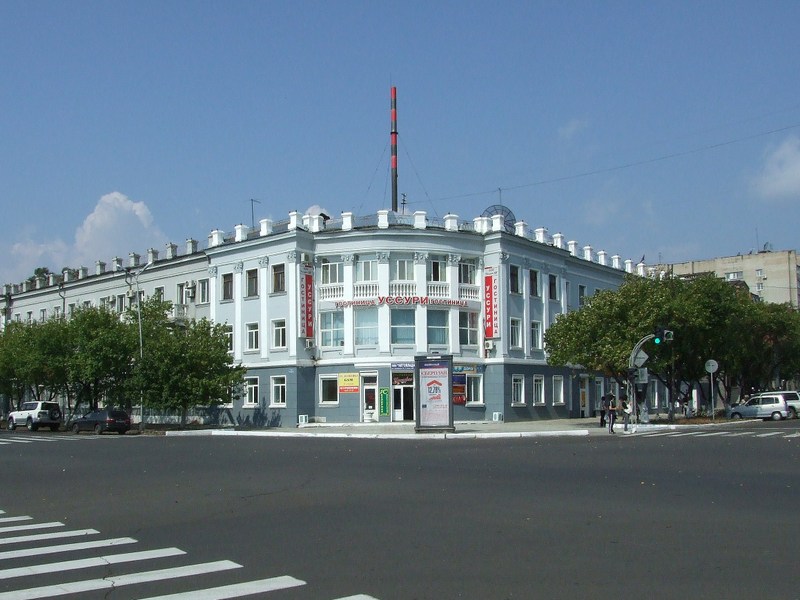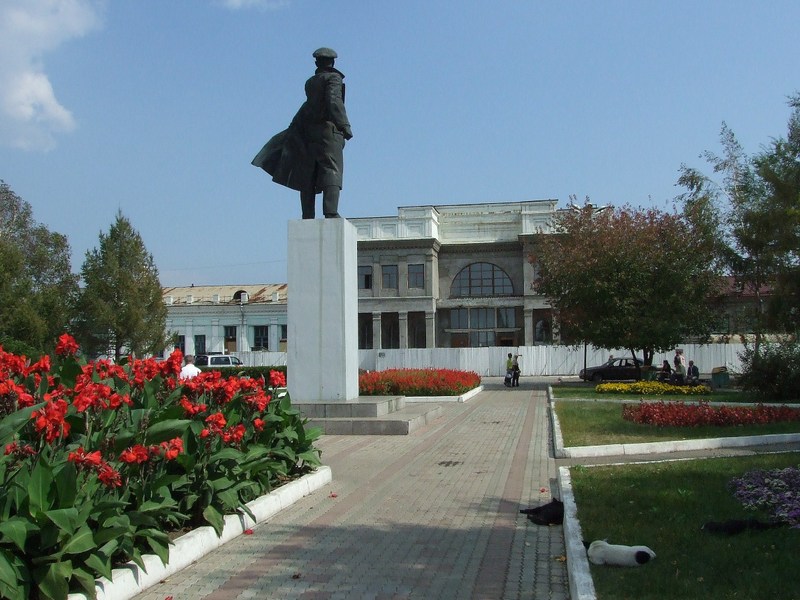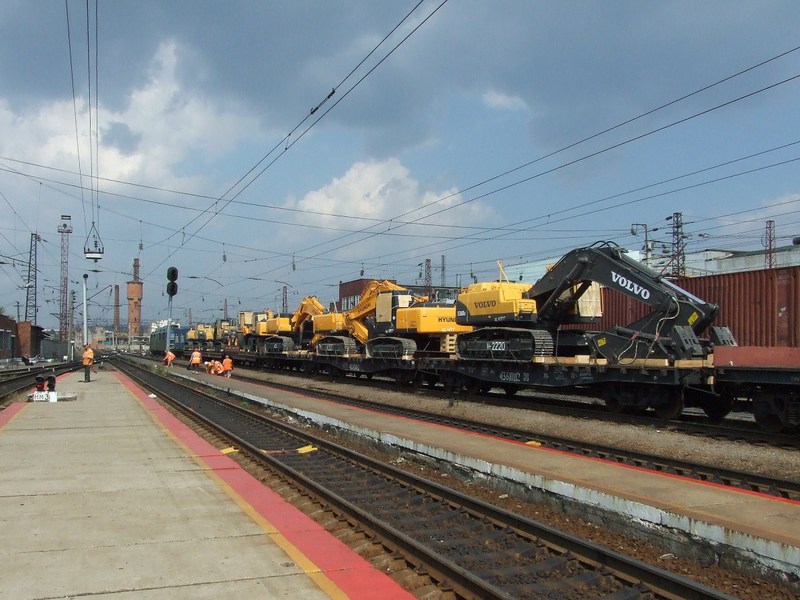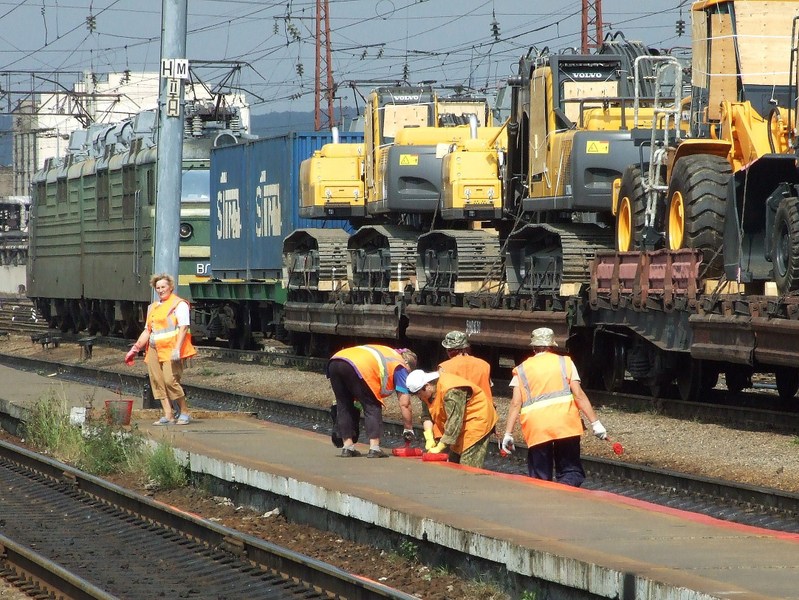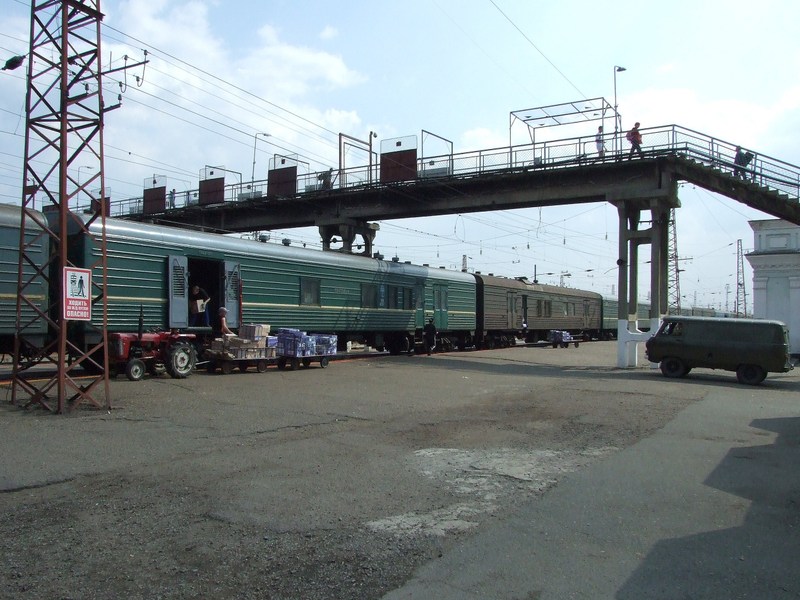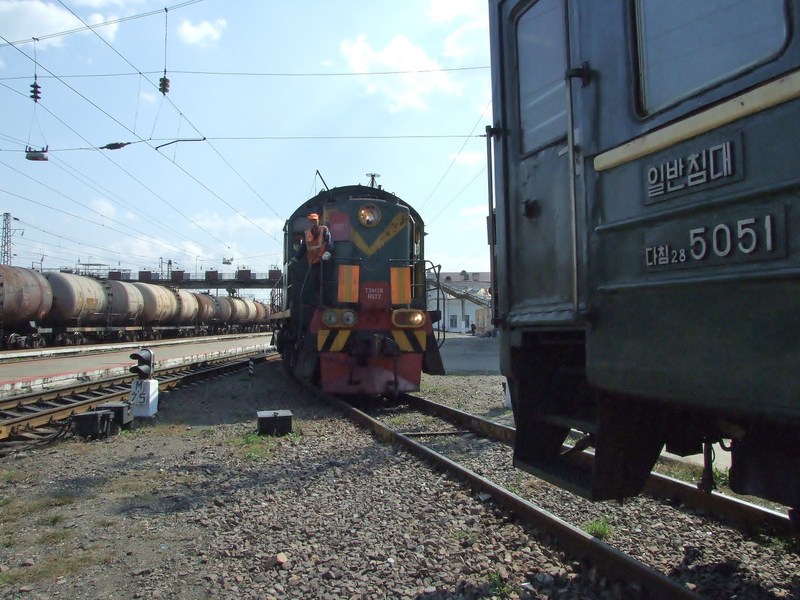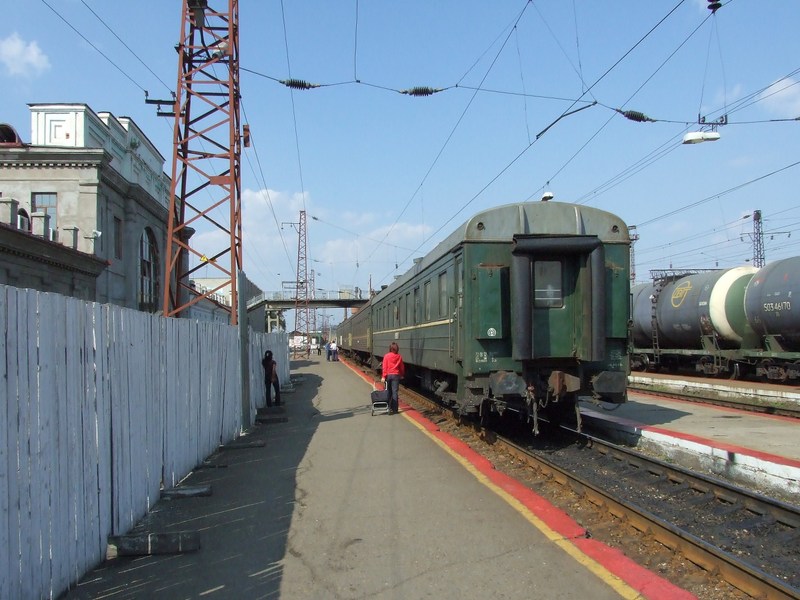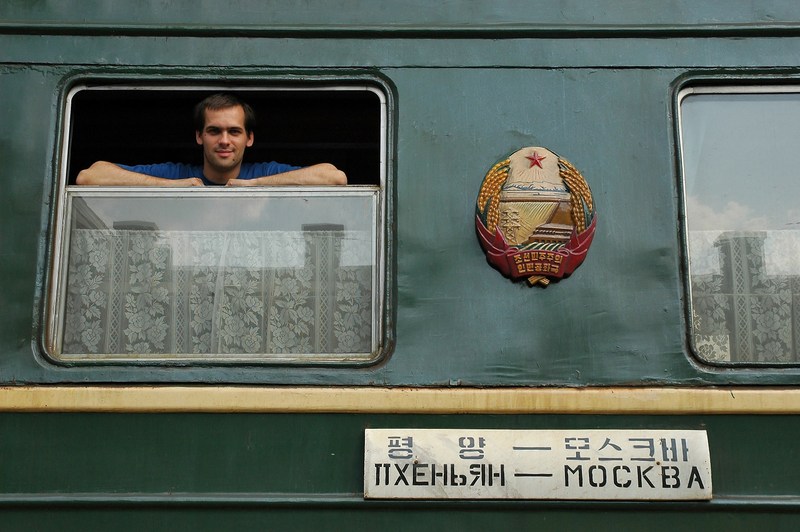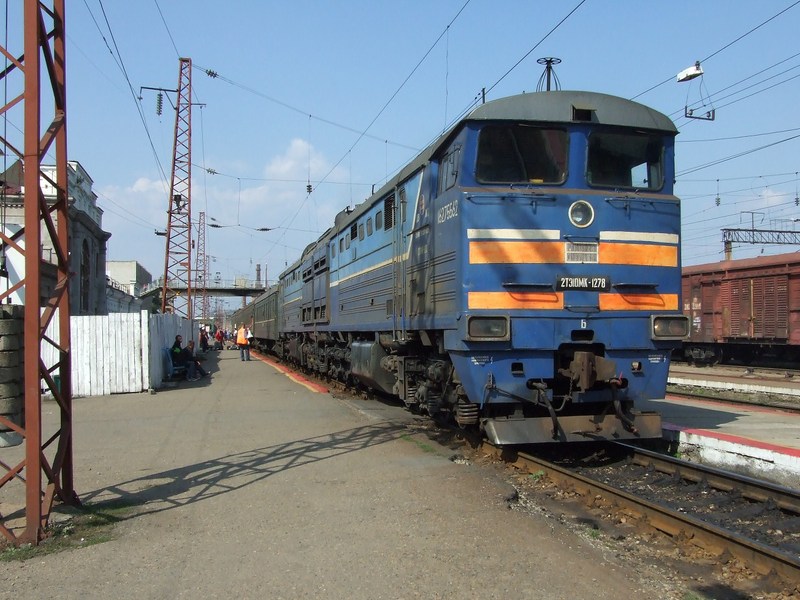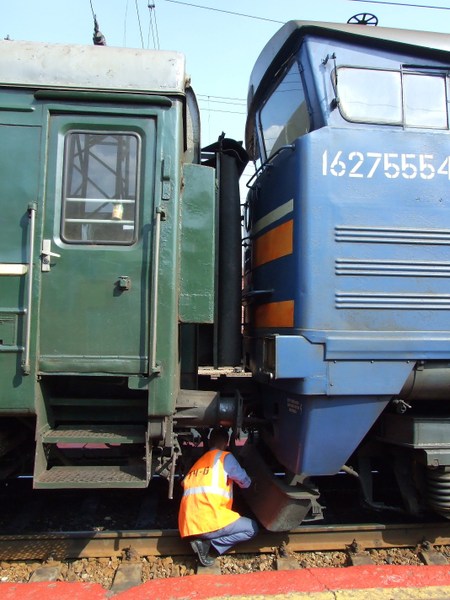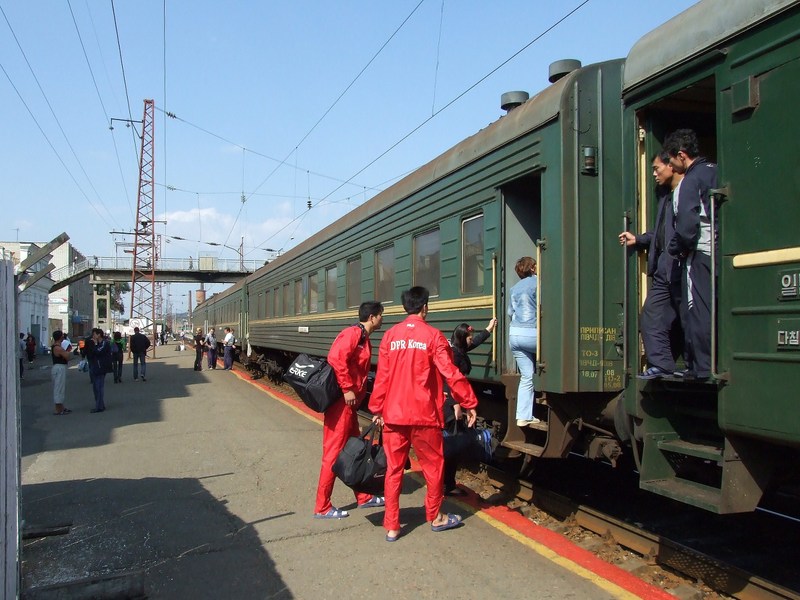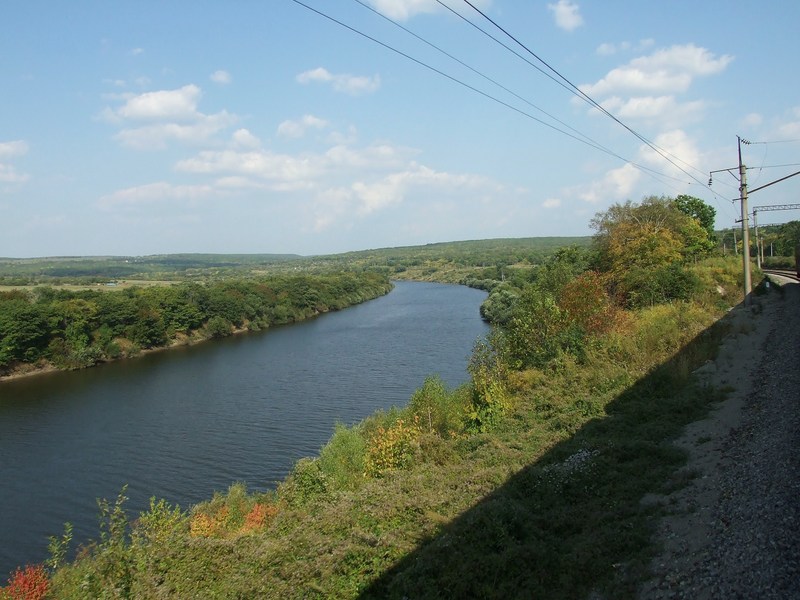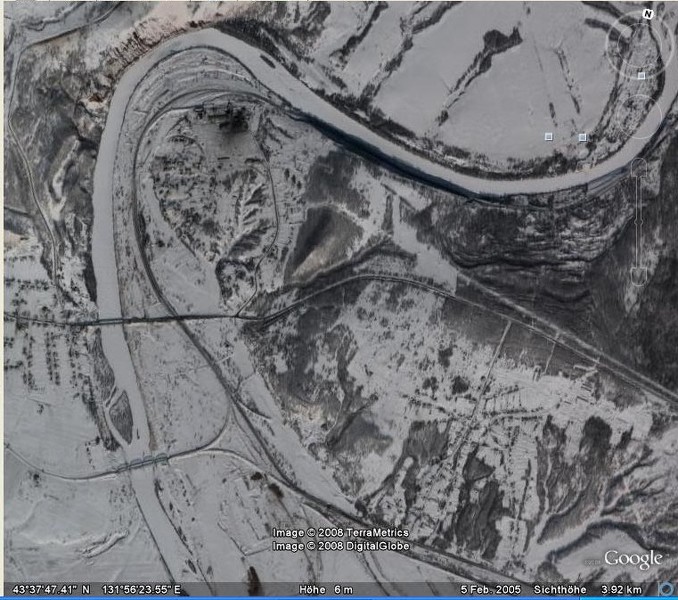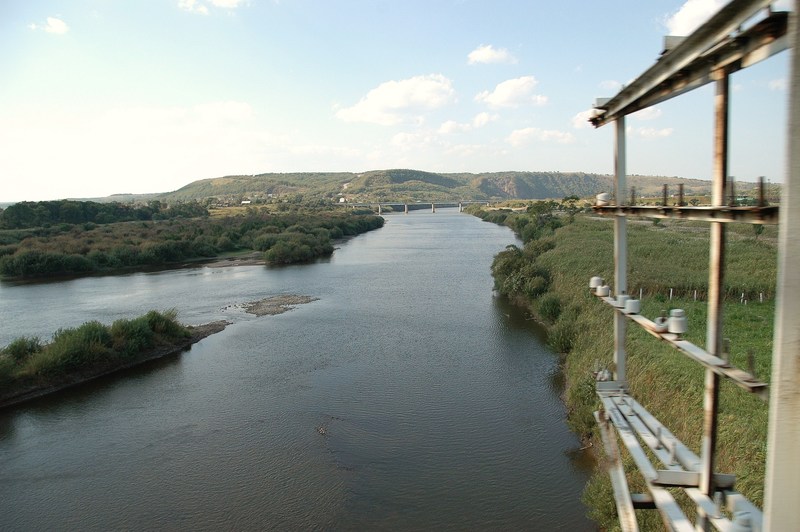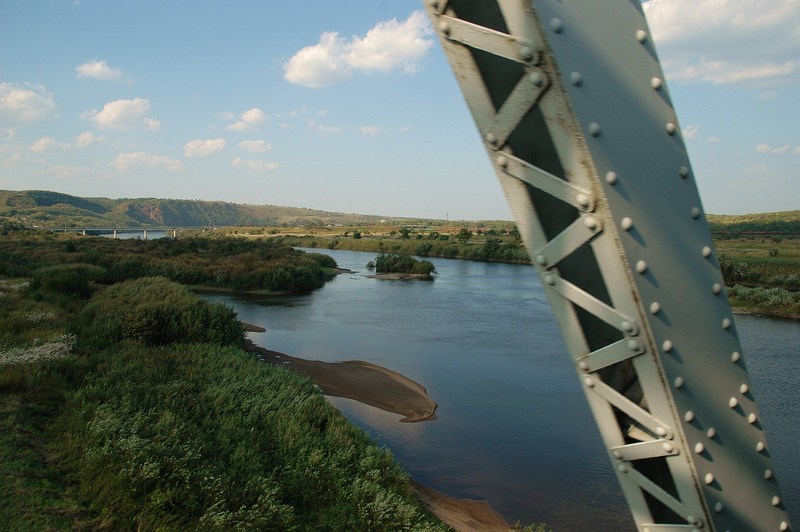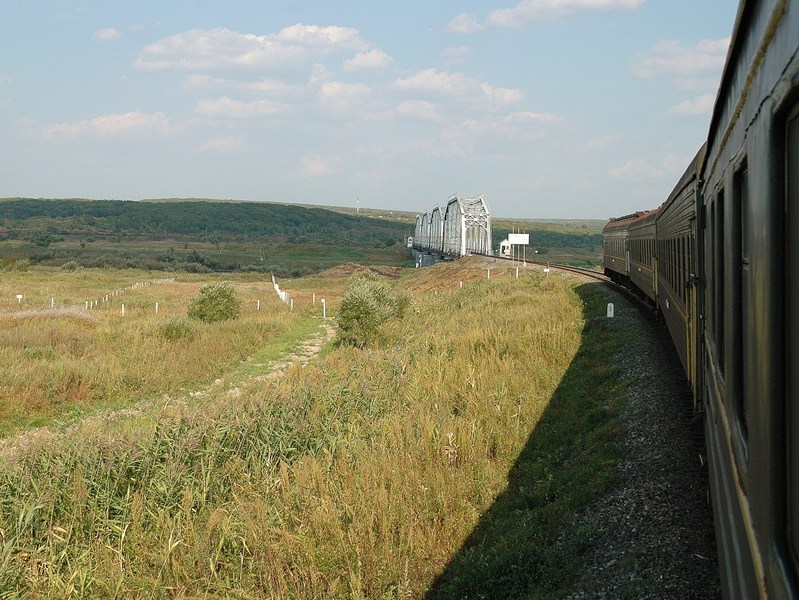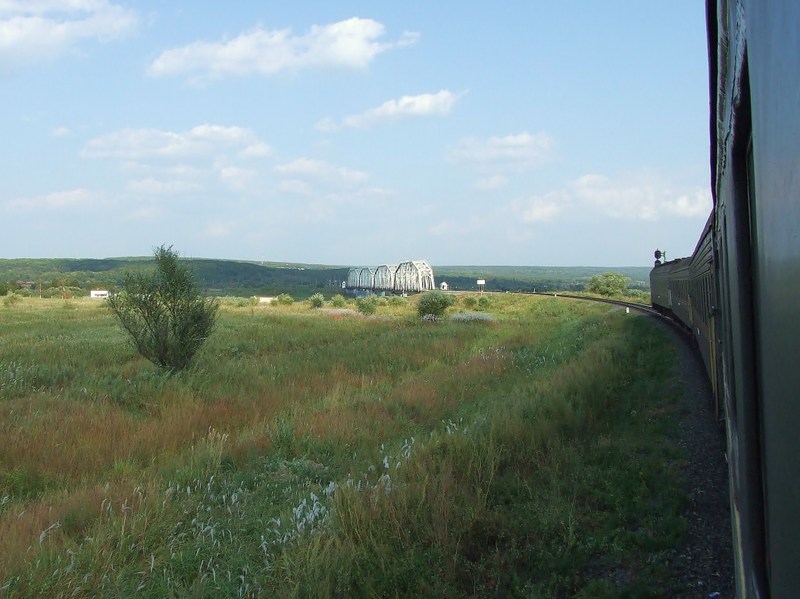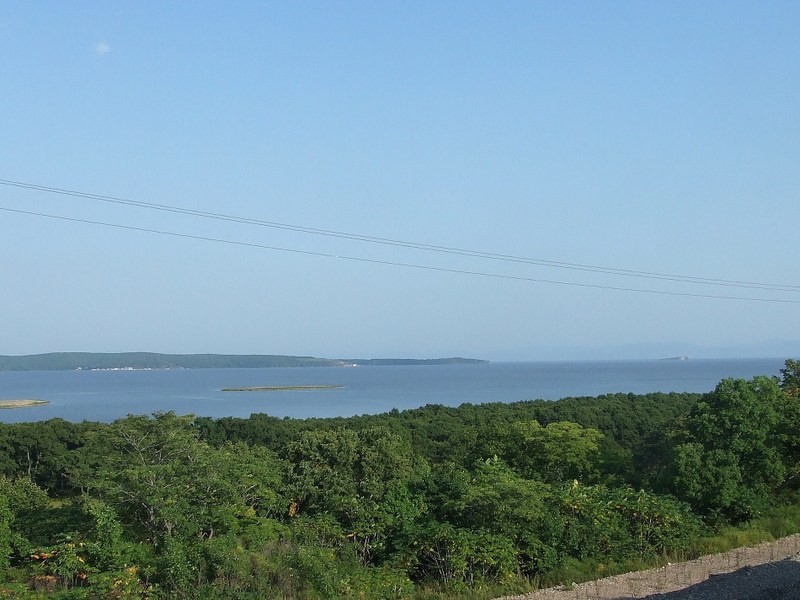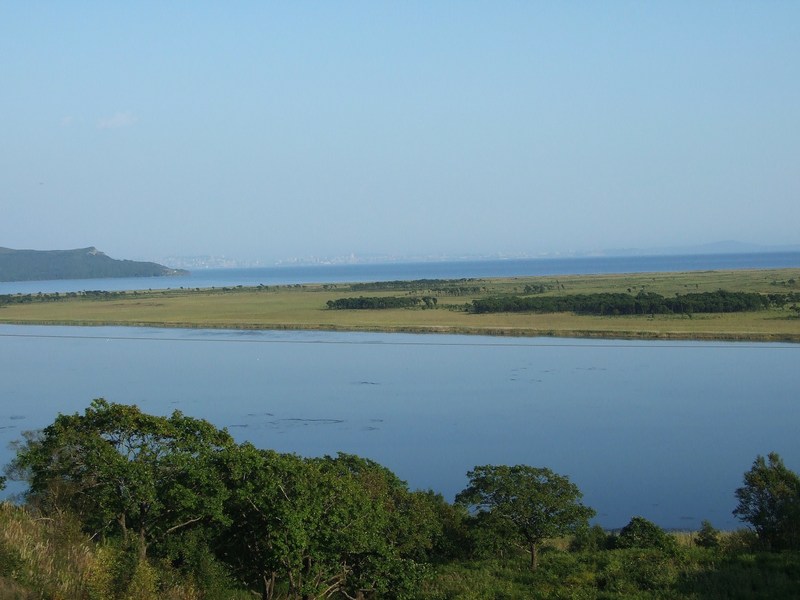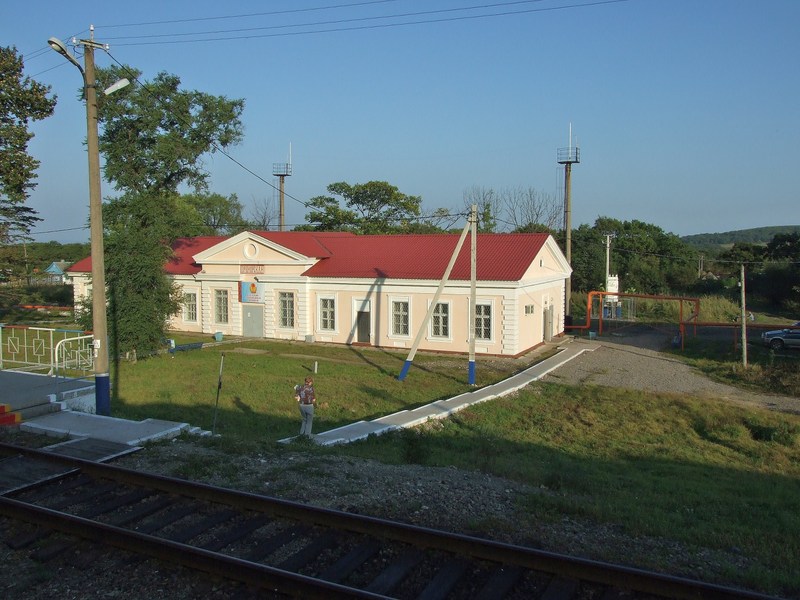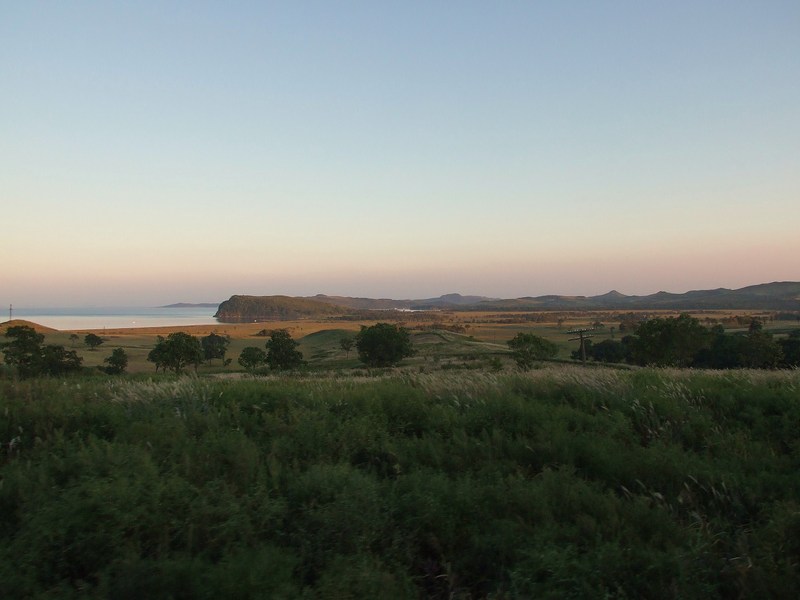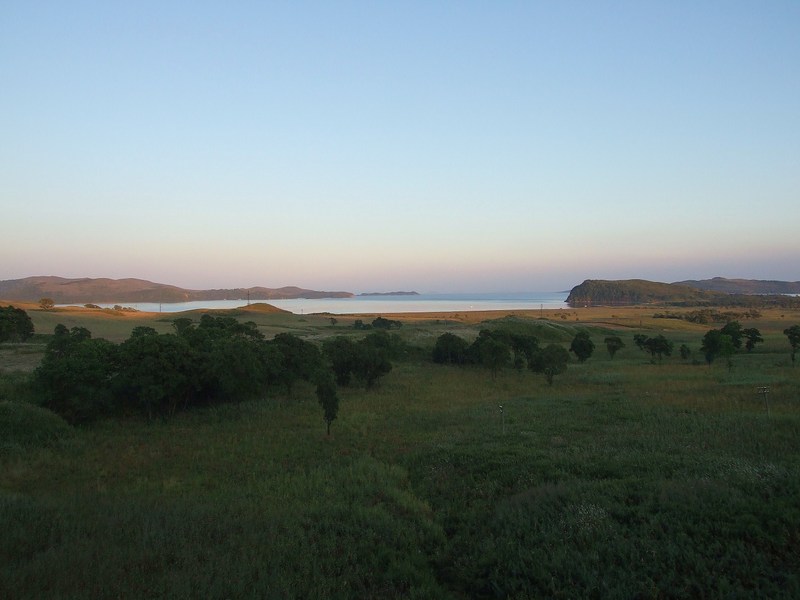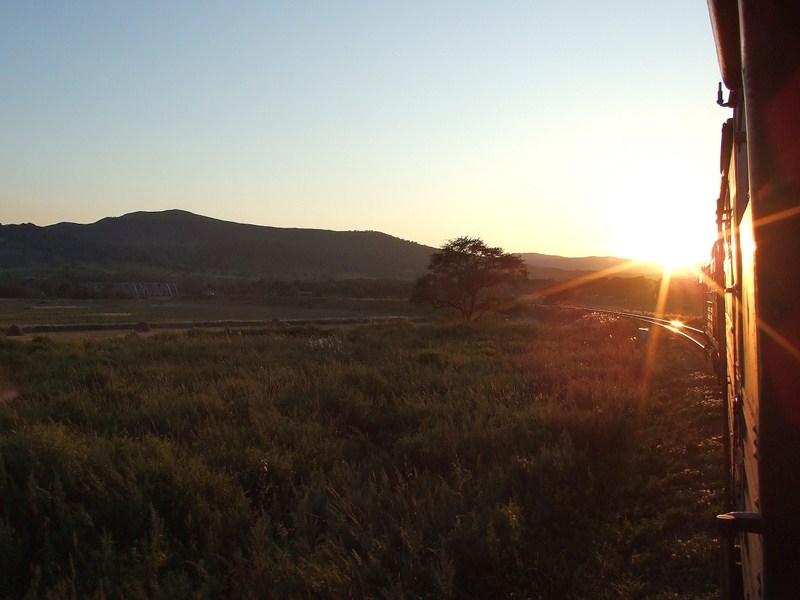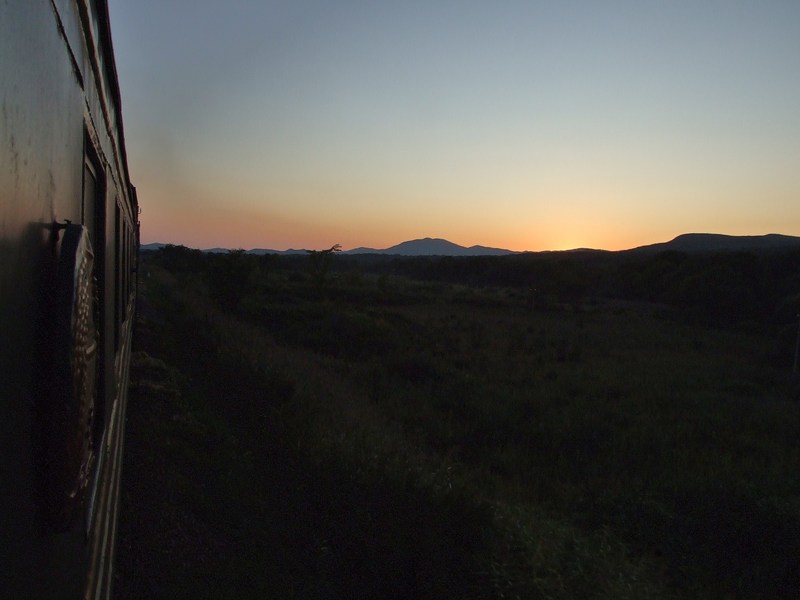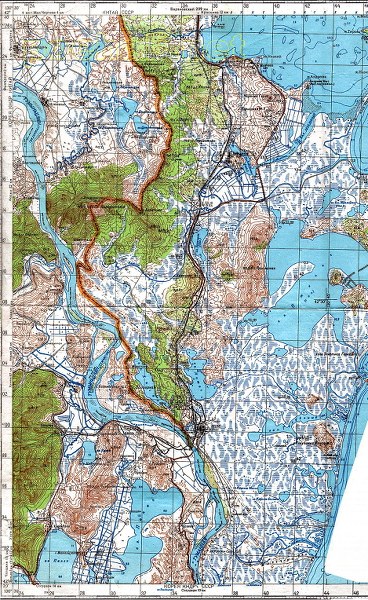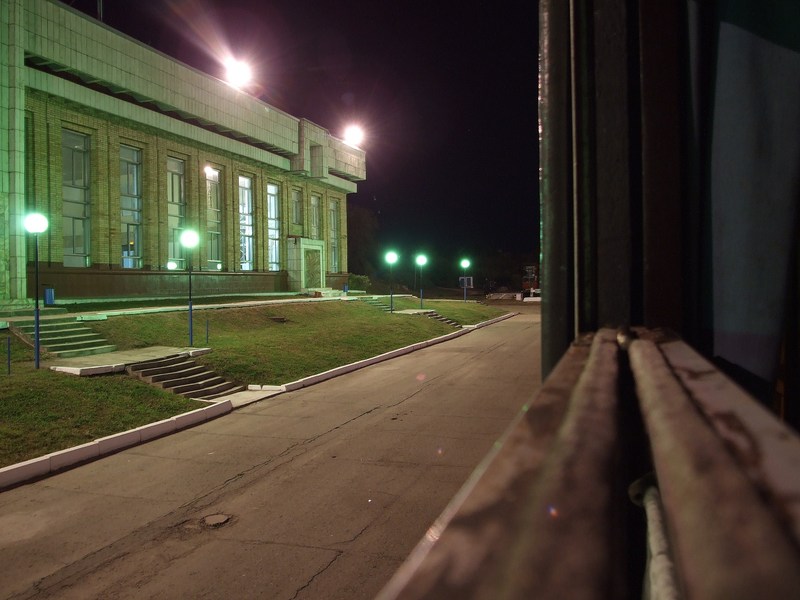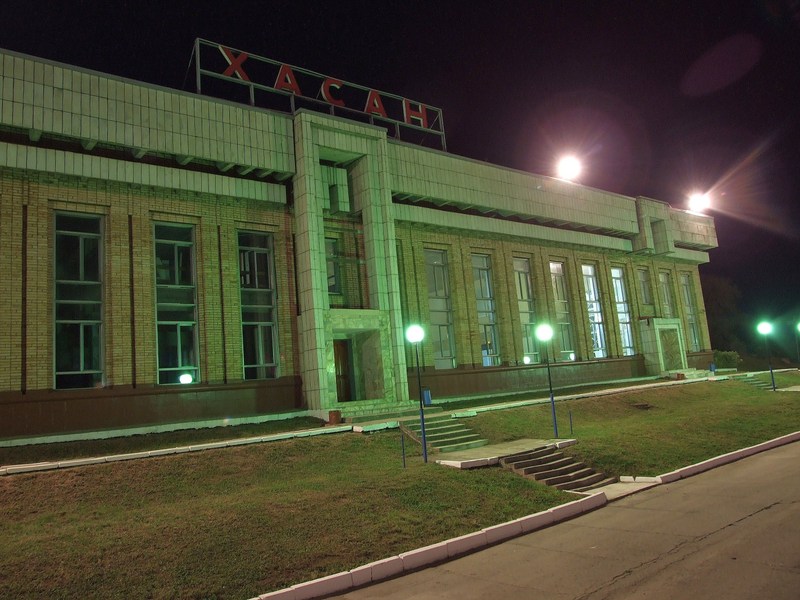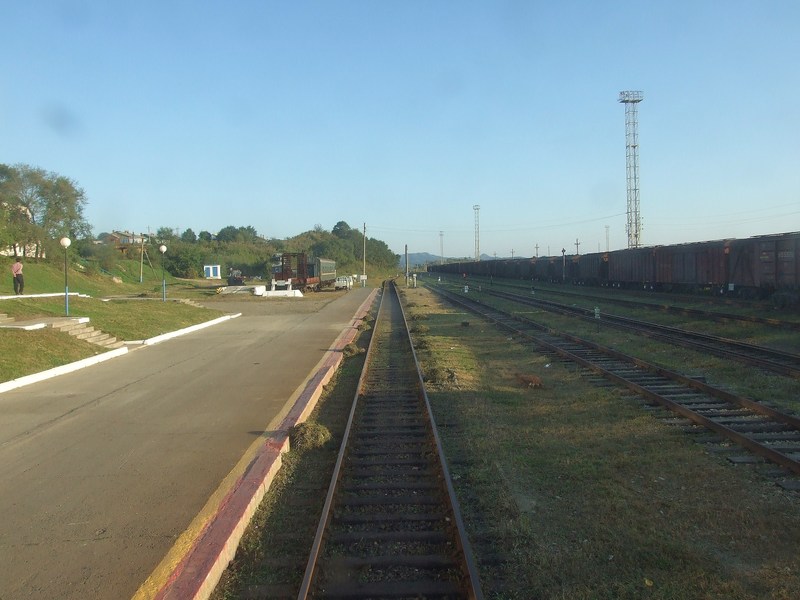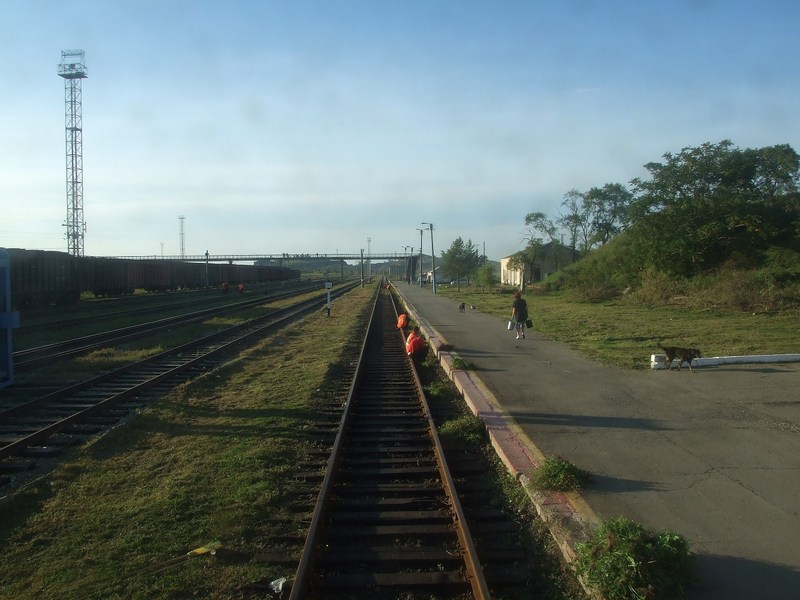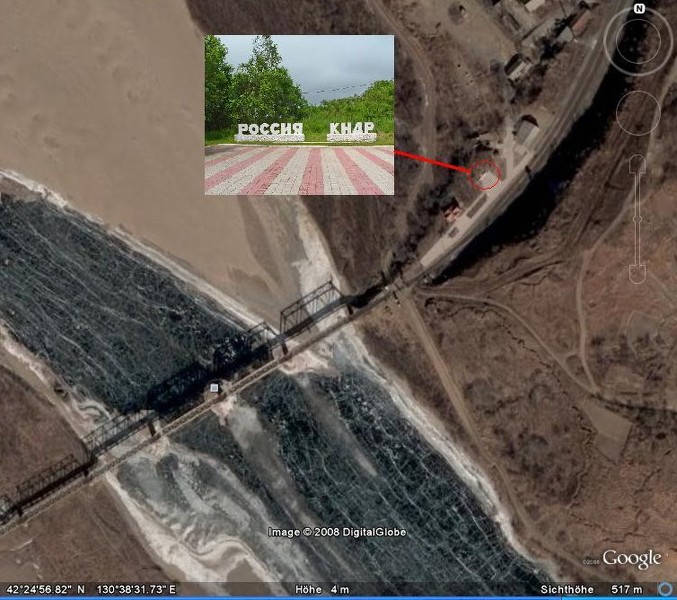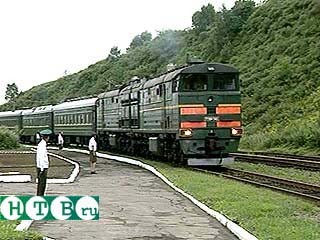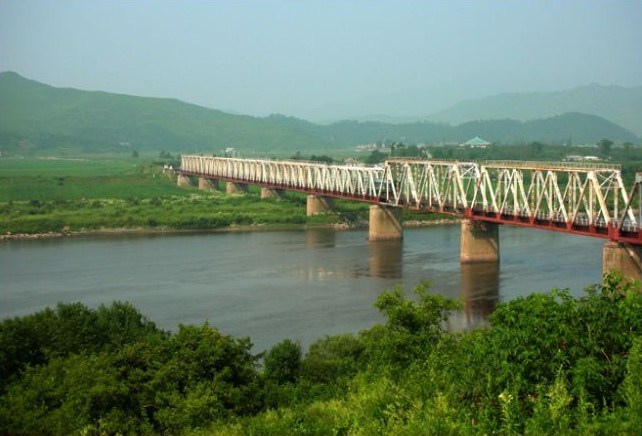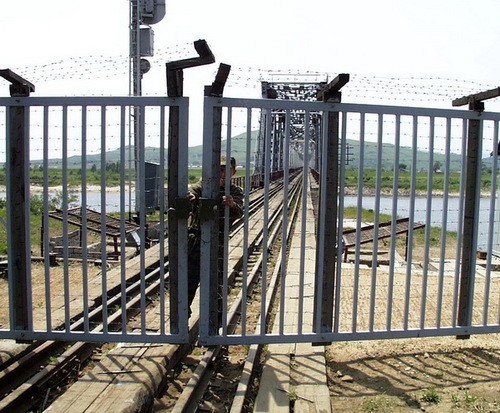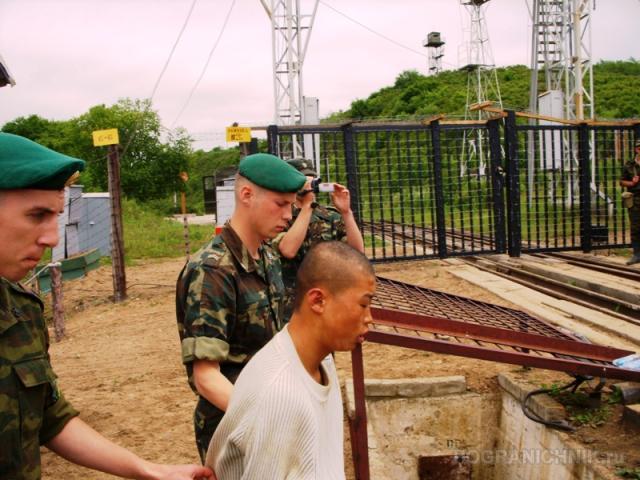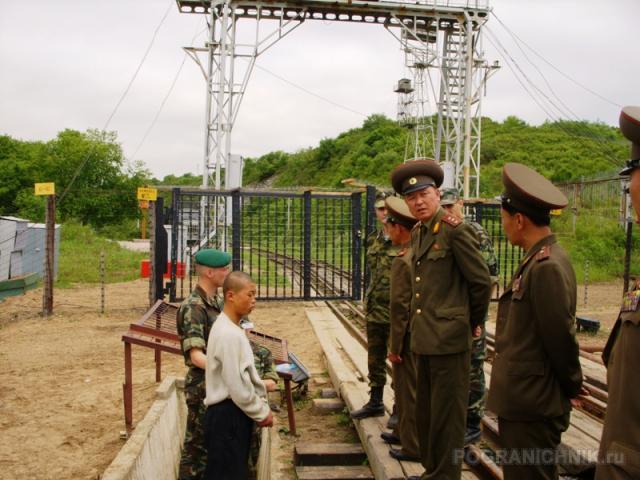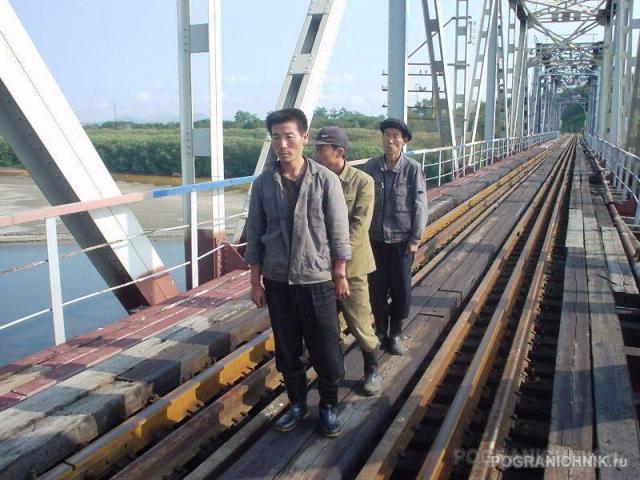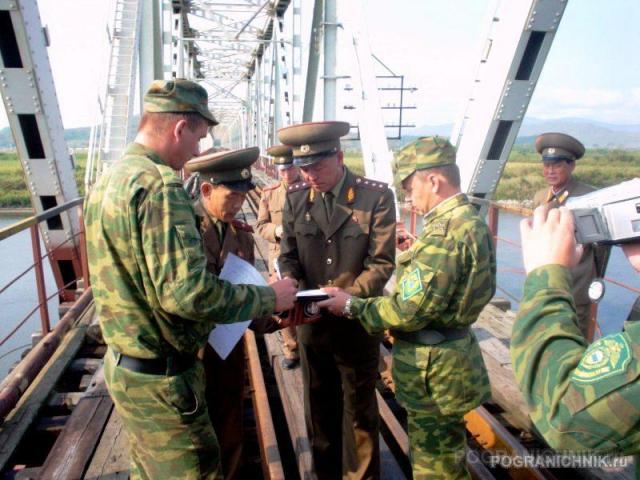DOWNLOAD HERE (~50 kB)
After the middle of the bridge we already had North Korean territory below the wheels. There were people under the bridge, they were working on some kind of field.They beckoned to us and we beckoned to them. We were surprised that they could be there just so close to the border.
Finally we reached the end of the bridge, which was guarded by some soldiers. A picture of the north Korean end of the brige, which I found somewhere on the internet:
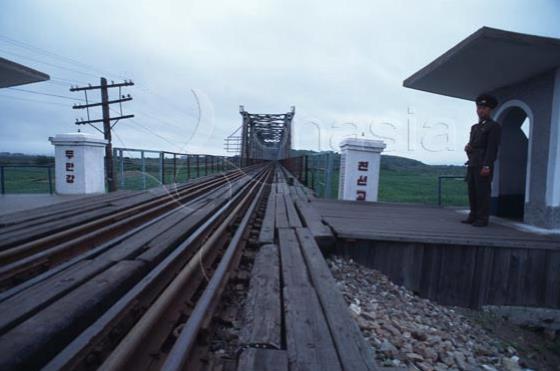
After a left turn, also guarded by soldiers say every 100 meters, we ran into the station of Tumangan. There were many tracks, but they all were empty. We didn't reach the final passenger station, but stopped before. Soldiers were entering the two wagons.
Our sleeping-car was divided from the other wagon and we were shunted to the regauging facility (North Korea uses normal gauge - 1435mm), which was located north of the main tracks. During that shunting one soldiers went through the sleeping-car to have a first look at the passengers. He was quite surprised to see us two, and considering his facial expression I imagined that he was thinking something like "Oh, hm, ah, hm. Who are they? What to do now?" because he didn't expect to meet other cititzen than North Korean people...
The sleeping car was parked at the the regauging facility. A female soldier came in and wanted to see our passport. She had a look at them and then gave them back to us.
Several other soldiers who hastily ran up and down on the corridor just had a short look at us.
There was a high loading platform outside and after some time a minibus (I think it was a Toyota...) arrived. Inside there were even more soldiers, maybe four or five. They jumped down to the track and entered the sleeping-car. Did they come especially for us?
We are not sure, but we think so... they came to our compartment. I said "Zdravstvujte" and one of them answered in Russian. He spoke Russian and then sat down on my bed. A colleague sat down opposite on Olivers bed. He asked us "Speak english?"
So at least communciation was no problem. Two other soldiers were standing in the door, one of them had many medals on his uniform. The Russian-speaking soldier introduced him as their commandant. I tested my best Korean and said "Annyonghaseyo" and he smiled back.
Our two "translators" (they were about 30-40 years old) then wanted to see our passports. They thoroughly checked our visas and asked for where we were going and for what purpose (I answered by pointing on the Korean word next to the words "Purpose of entry" on my visa...). They asked for our nationality and I had the impression that they initially didn't exactly understand from what country I was from. I don't know how Austria is said in Korean language, and they didn't seem to know the Russian word "Avstriya". I finally tried to explain by drawing a map and saying that "Avstriya" is "nedaleko" (close) to "Germaniya"...
They sat quite a while with us and asked us also what was our job, what we knew about North Korea, how our media is reporting abouth North Korea, how we think about the United States, whether we have been there or were planning to go there, what we were thinking about Kim Jong Il and so on…of course we answered diplomatically.
Finally they put the long-awaited stamp in our passport.
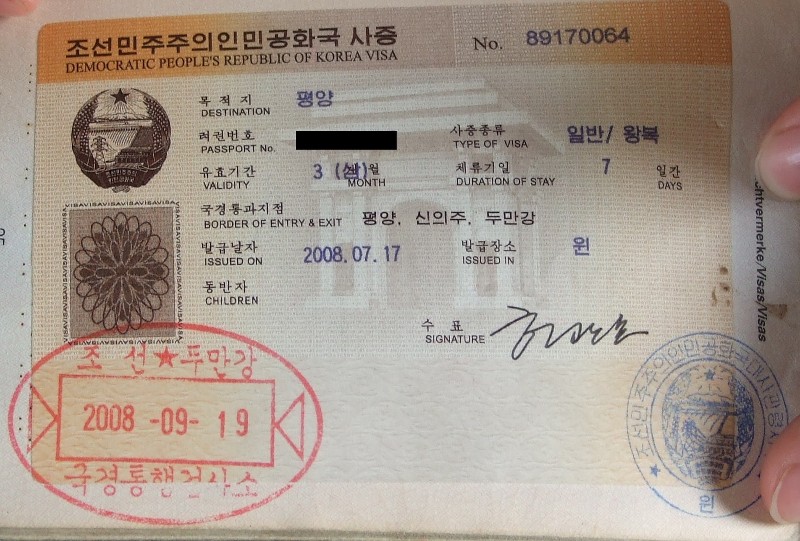
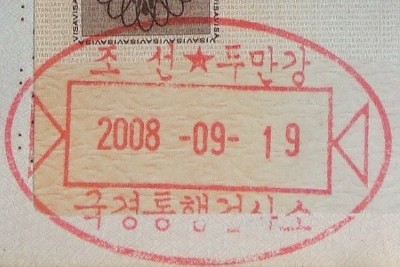
Now we had officially entered North Korea via Tumangan! "The Songun-era began", we were joking...
The stamp was a real trophy and maybe few people understand the special meaning it had for us and why we took all the potential risks just to get this stamp. Relatives and friends consider me quite crazy...
After that a customs official came into our compartment. The other two remained as translators. We were each given a customs declaration form (in english). And of course we had to open our backpacks and had to show nearly every single item which was inside. Filling in the customs declaration was a little bit chaotic, something we wrote down accordning to the questions, some items we listed because the official wanted that we list it. Some things he wrote himself on the declaration in Korean language. He was very interested in our books and checked them, but they were quite harmless: A RZD timetable, a Russian railway atlas, a travel-guide about "Molvania" and so on. Also cameras, my laptop and several USB-sticks drew attention.
And of course the mobile-phones were of special interest, as they are forbidden in North Korea. The "translator" said, that they would be sealed and that we must open the envelope only when we leave the country. The sealing was quite simple: The customs official asked me for some of paper (obviously they didn't have their own...) and I gave him two empty DIN-A4-sheets, in which he enwraped the mobile phones and which he closed with a yellow tape, which he then stamped several times...
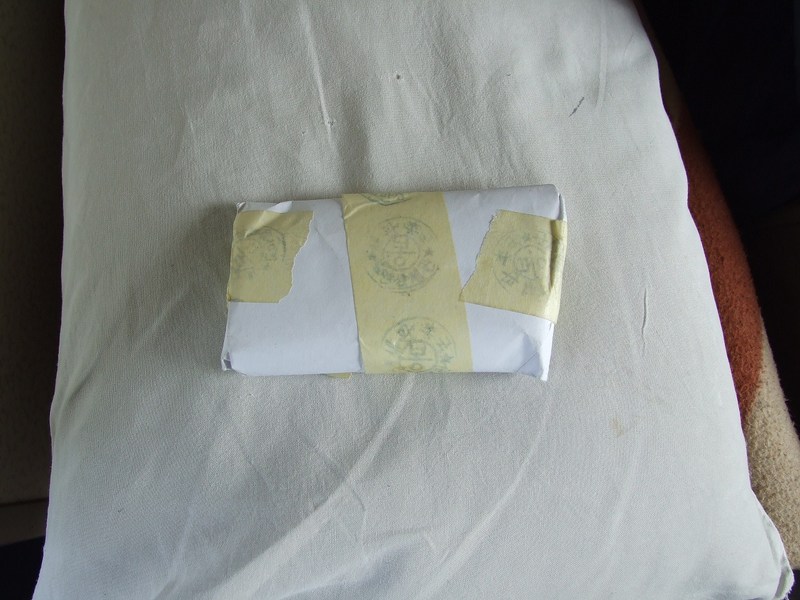
One of Olivers CDs also drew attention, as on it's cover some some "lightly" dressed women were shown. They asked whether the CD contains some kind of pornography, but were content with the explanation that it only contains music.
Finally it seemed that the customs declaration was complete. We were told that we would have to show this declaratiuon when we leave North Korea and that we must not leave any single item listed on it in North Korea.
They told us, that they now have to take the books, the laptop, the camera and the USB-sticks with them for some further inspection by a specialist, and that we would receive our belongings later.
They asked us to put all this items into the two smaller backpack (both of us had a big and a small backpack). Then they took the backpacks and left the sleeping-car.
Meanwhile the regauging procedure was nearly finished. Due to the long immigration and customs check we didn't notice much of the regauging.
I don't remember how much time passed since we arrived at Tumangan (at about 10:30 local time = 12:30 local time in Khasan = 5:30 Moscow time), but I think it was something like two or three hours.
Now we could leave the sleeping car – the first steps on North Korean territory. The regauging facility here was quite old and in a bad condition, but it obviously worked. It was only designed for two passenger wagons to be regauged simultaneously, but that seemed enough…
The other passengers went away to the station. The loading platform seemed not be used for loading freight anymore, but as a public road. Several people came about on foot, by bike or by moped.
After some time the minibus, which brought the soldiers, arrived again. The conductors said that they now would have lunch somewhere and and would lock the sleeping car. They asked us whether we would like to join them, but we decided to stay here. Maybe it would have been the better decision to join them, as this would have been an unforgettable experience.
Then they left using the minibus.
And we?
We were standing next to the sleeping-car at the regauging facility of Tumangan. No soldier, no guide, no conductor... nobody took care of us or what we did...
We were really surprised about so much freedom in North Korea! Usually something like that is totally impossible for tourists in North Korea...
At this point, some basic information about tourism in North Korea:
Tourists can travel to North Korea only under a pre-arranged trip. All trips are guided and the guides wait for the tourists at the station or airport at Pyongyang (apart from special resorts for Russian or South Korean tourists, all trips start and end in Pyongyang). Most tourists travel to North Korea in a group, but also individual trips are possible, but also if somebody travels alone, he/she will be accompanied by two guides and one driver. It is not allowed to leave the hotel without the guides.
During the time in North Korea tourists make various excursions to sights in Pyongyang and other regions of North Korea. However, only the typical tourist hot spots can be visited and the schedule has to be planned in advance also for individual tourists.
After arrival in Pyongyang all transportation is by car or chartered bus. Using public transport – apart from two stops of the Pyongyang underground – is impossible for tourists...
We then just sat on the loading platform and watched the scenery. A diesel shunting engine was pulling the Russian "plazkartniy"-wagon somewhere. I am not sure now, but I think it was a North Korea engine, which would mean that the North Korean railways have broad-gauge engines?
Nothing else happened. As said earlier, all tracks were empty and no evidence for intense cross-border freight traffic could be seen.
South of the tracks there was a maize field and some people were working there. We noticed music coming from loudspeakers somewhere. Maybe propaganda-songs to motivate the workers?
However, after some time sitting here was too boring and we decided to walk to the station and just try, whether somebody would stop us…
But nothing happened. We could easily walk to the station. The first part was on the loading platform, then on a small road next to the tracks. There were many people walking, cycling or moving by ox-cart there. Of course they looked at us, but didn't pay much attention.
I think we were not a big sensation for them, as they often see Russian people here and were now maybe thinking that we were Russian too. However, I assume that the Russian tourists usually arriving here at Tumangan can't walk around the station as we did, but that they are after immigration and customs immideately picked up and brought by bus to the sea-resorts designed for them...
On the tracks we saw about five persons who were digging around in the track ballast (well, it was just a mixture of sand and stones…). Apparently it was there job, but it just dispersed dust; of course such work doesn't help to improve the inferiour track condition...
After some time the road crossed the tracks and leaded to the platform. On the platform there was an obelisk with some inscriptions as well as a big stone-board with a Kim-Il-Sung portrait.
We went to the station building, which was located some more meters in the west. There were other people on the platform, but also they didn't pay much attention to us.
The total distance from the regauging facility was about one kilometer:

When we reached the main buliding of the station a woman aproached us and asked us (in Russian) whether we would like to visit the shop inside the station.
The shop appeared to be a souvenir-shop aimed at Russian tourists. Of course I couldn't resist to buy some old Pyongyang-postcards – "Shopping at Tumangan!".
After that we walked to the gate, where the road, on which we came, left the station area. We passed it and nobody prevented us from walking some meters on the main street of Tumangan. It was not asphalted and on the other side of the road there were some small houses.
I think we could have walked even more inside the village, but we thought that it was maybe better not to overstrain the freedom...
We then returned to the sleeping-car. Nobody was there and it was still locked. So we waited. It was already about 15:00. The position of the sun was ideal for taking photos, but our cameras where somewhere at the customs office... :-(
After some time a car (the same minibus again) came and two of the conductors got off. They opened the door and now we finally could have some lunch inside our compartment.
About half an hour later the car came again and the custom official and one of the soldiers gave us our customs declaration, but not our stuff. They said that they would give it to us later after the sleeping-car would have been shunted to the platform.
Maybe 15 minutes later a diesel locomotive approached our sleeping car. It was a relatievly new locomotive and obviously bought 2nd hand from China. The sleeping car was coupled to it and we where shunted to another track closer to the station.
We then decided to walk once more to the station. I thought that maybe we could ask for the customs office to get our stuff back.
The domestic train no. 7 from Pyongyang to Tumangan still had not arrived. According to the Russian timetable (the timetable attached on the corridor inside our sleeping-car only listed stations from Moscow till Khasan - no timetable for North Korea...) it was due to arrive here at 10:40, but now it was already 16:30...
And it should leave Tumangan for Pyongyang at 17:50. There were already some passengers in the waiting room inside the station building. Some noticed us standing on the platform and looked at us with interested eyes...
We debated whether we should go in and raise even more attention... after some time we decided to go in. Nothing happened, people were looking at us while we studie the timetable and the fare-table attached on a wall. The timetable listed two train-pairs: Trains 7/8 from/to Pyongyang (but with a departure time slightly differing from the RZD timetable – 17:00 from Tumangan) and a train-pair with 900-numbers from/to some other place.
The fare table listed fares to various destinations. For every destination two different prices were listed, maybe different classes or for adults and children. The price range was up to maybe 5000 won, if I remember correctly.
And of course there were portraits of the two Kims, overlooking the scenery...
Back on the platform again, I approached an official and asked him whether he spoke Russian. He did! I asked him for the way to the customs office and he told me that it was located at the western end of the platform and that the entrance was labeled also in Russian.
We went there and found the door, but it was closed. But next to it there was an open window and through it we saw a woman working on a computer and in the background we saw our our small backpacks.
With some Russian words we drew attention to ourselves. The woman didn't understand us, but she called somebody else. Another customs official came to the window and started to speak to us – in French!!!
I don't speak French, but fortunately Oliver's French knowledge is quite good and so he could explain the situation. They officer was friendly and told us to use the side-entry to get in. We then could take our stuff and the officer wanted that we check, whether everything was still there. Everything was complete and with "merci beaucoup" and "au revoir" we left the customs office of Tumangan....
Now I had of course to try to take some photos. And it was possible without problems...however, I tried to behave not too eye-catching.
The main building and the only platform:
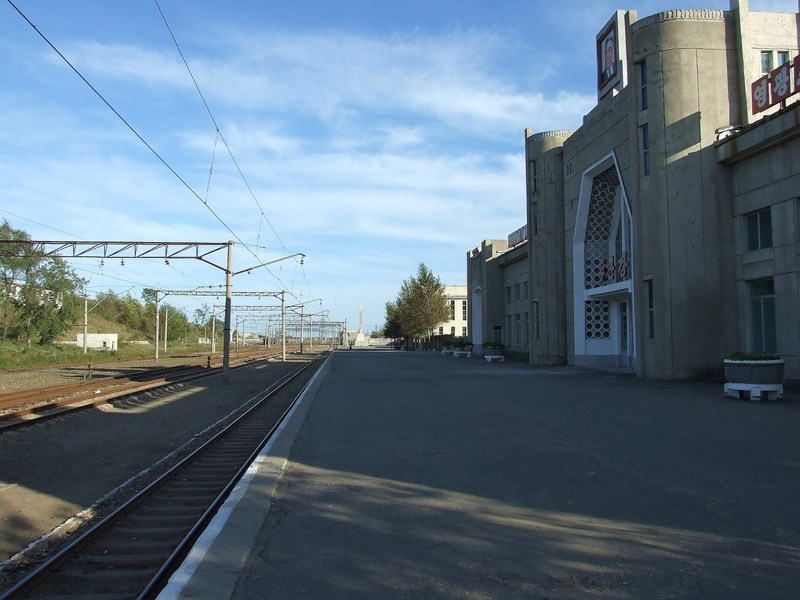
The entrance with the typical Kim-Il-Sung portrait – from now on the Great Leader was always with us...
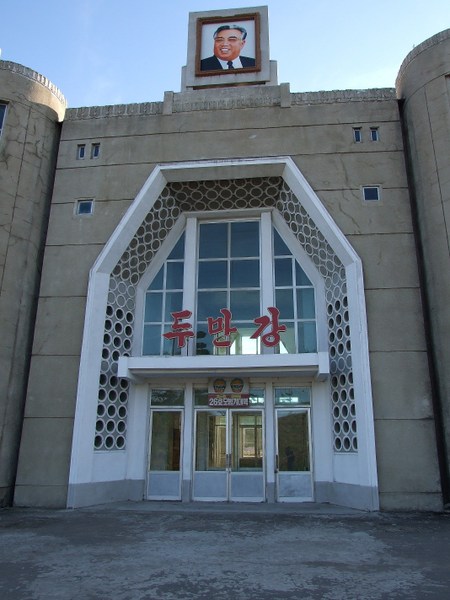
The tracks:
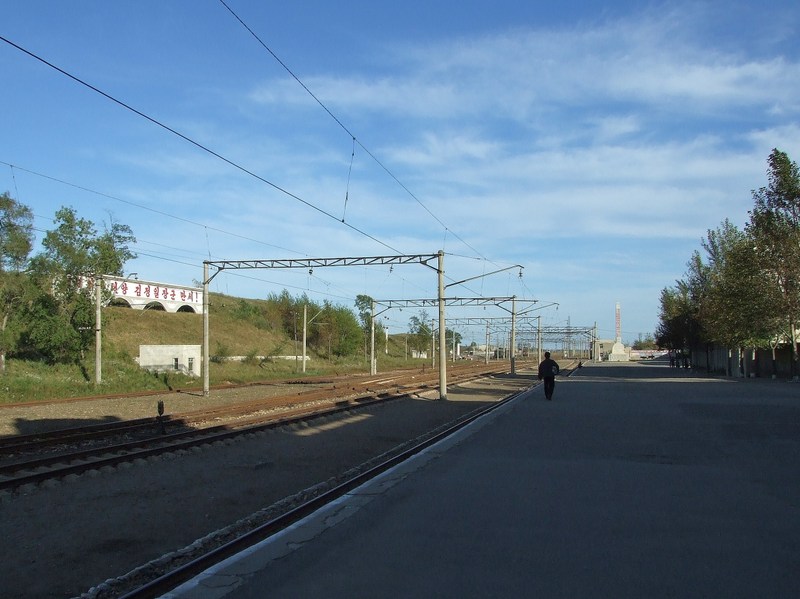
The obelisk and the stone-plate with another Kim-Il-Sung picture…
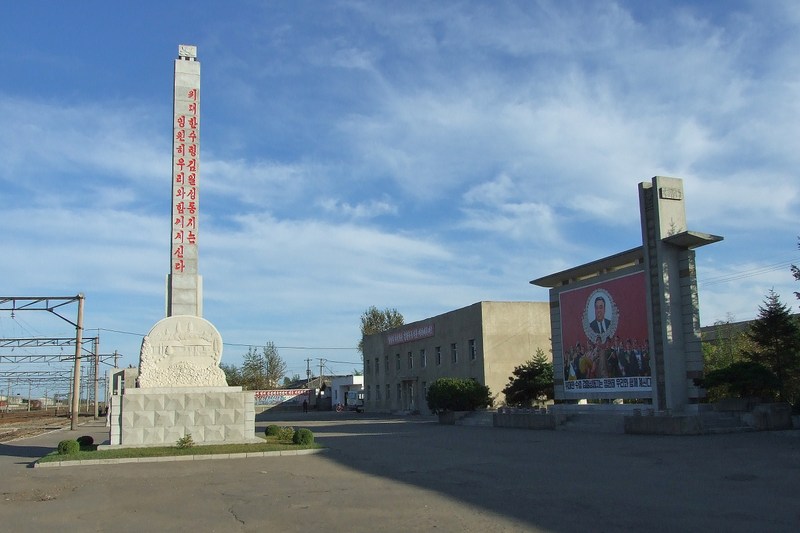
We walked back to the sleeping car:
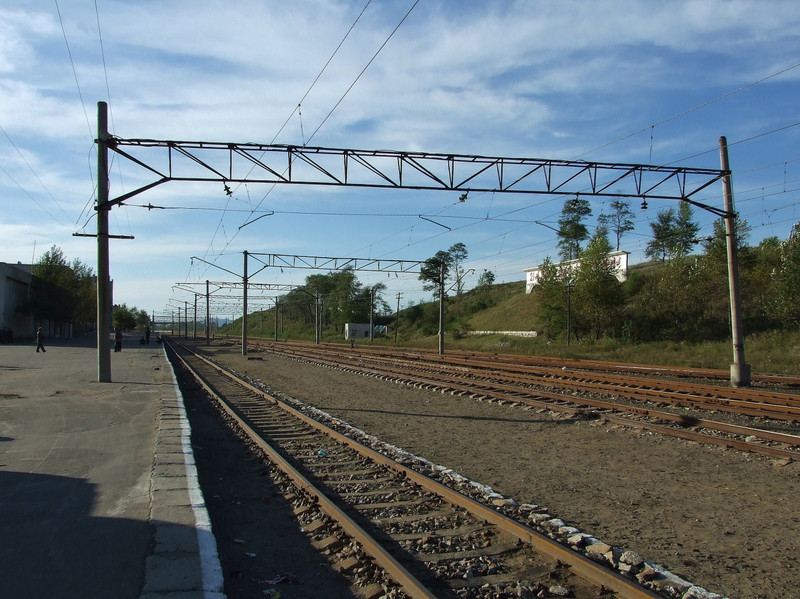
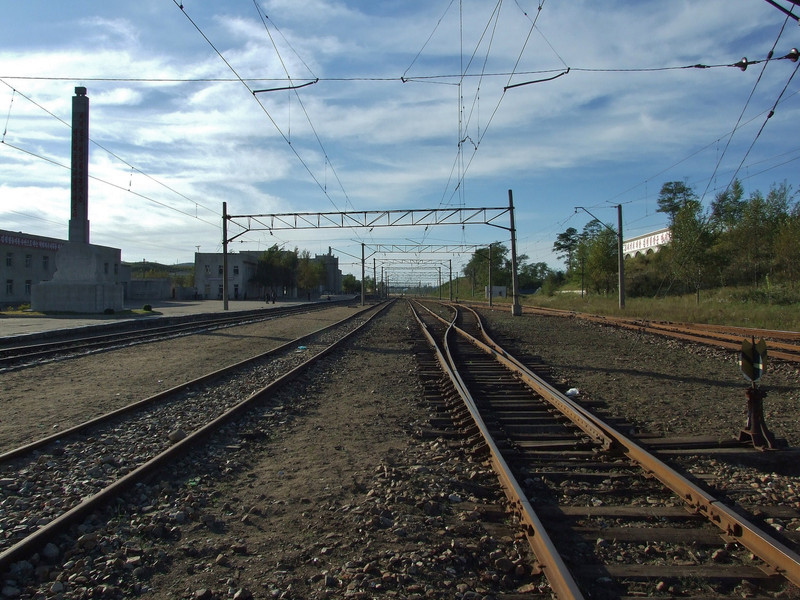
The sleeping-car Moscow – Pyongyang at Tumangan:
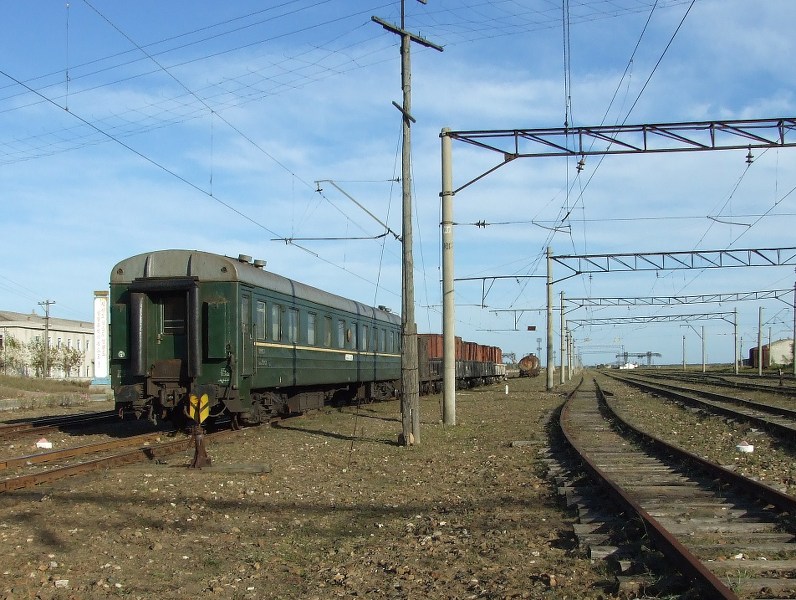
Next to it there were some freight cars:

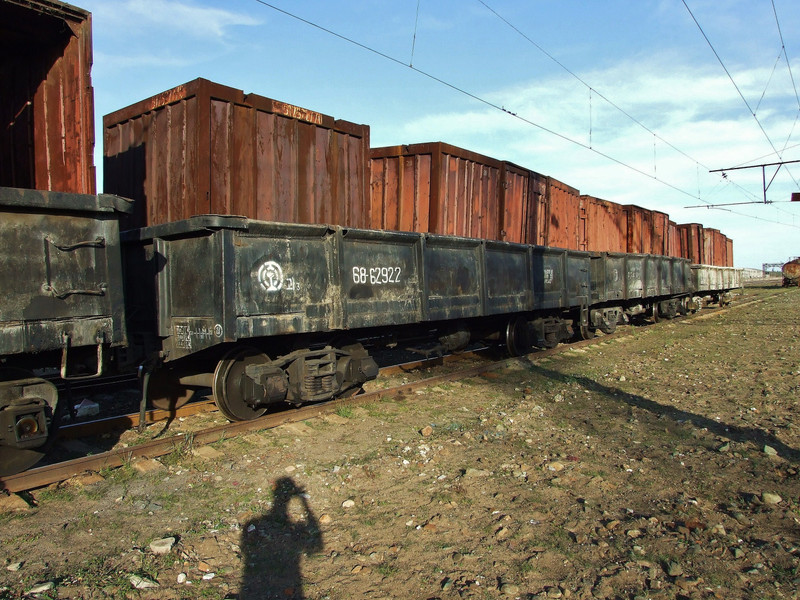
Some locomotives parked on another track:
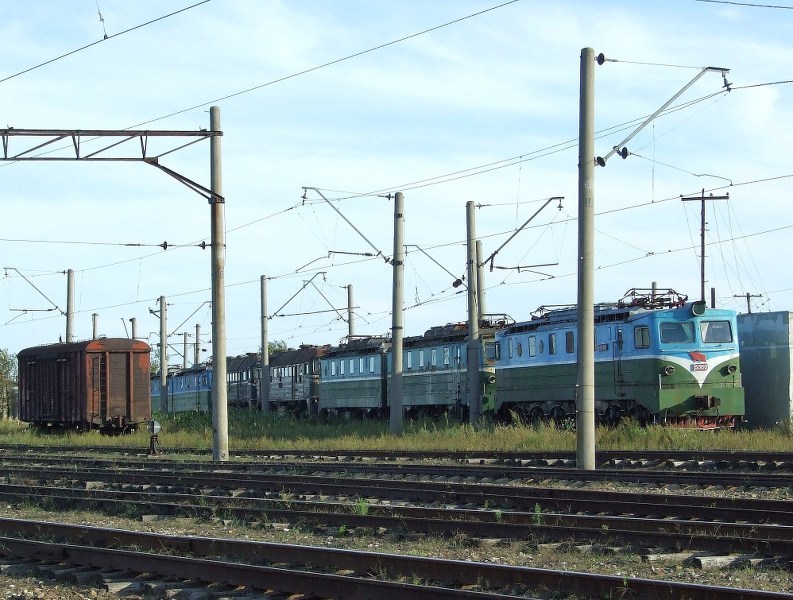
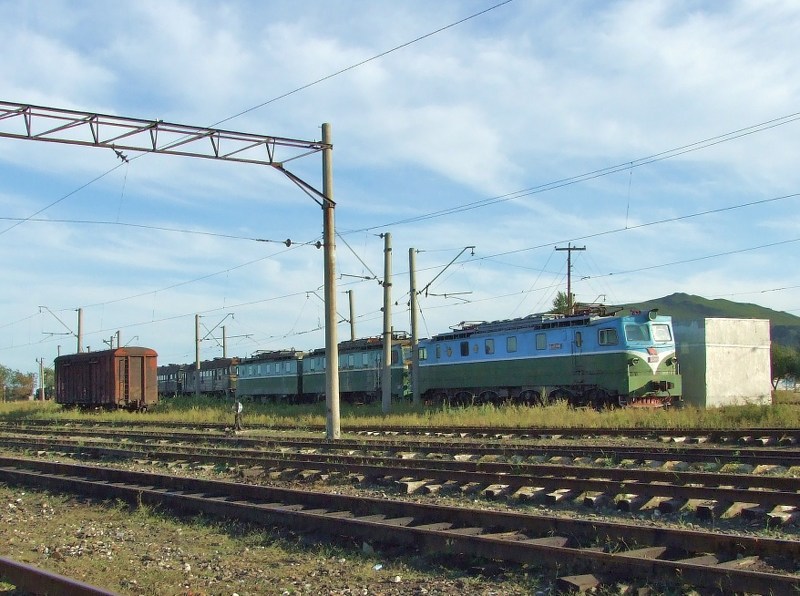
I'm not sure whether all of them were still working...
Empty tracks leading to Russia:
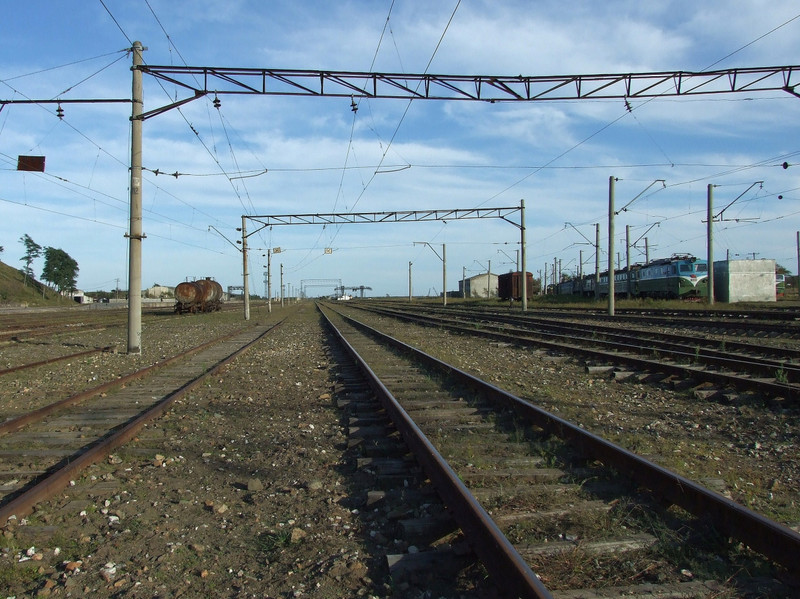
View towards the passenger station:
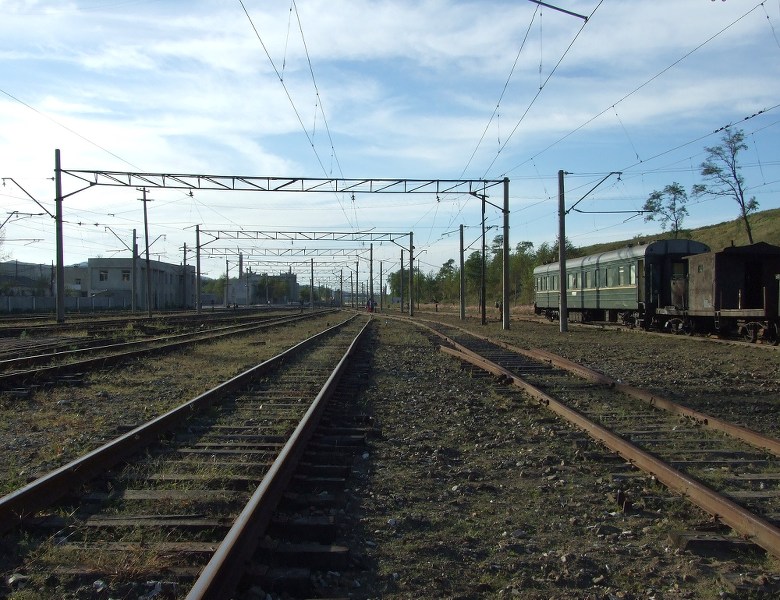
The loading platform and the regauging facility. In the background you can see the woman, who was the first to check our passports after we arrived and some persons sitting on the track and digging around...
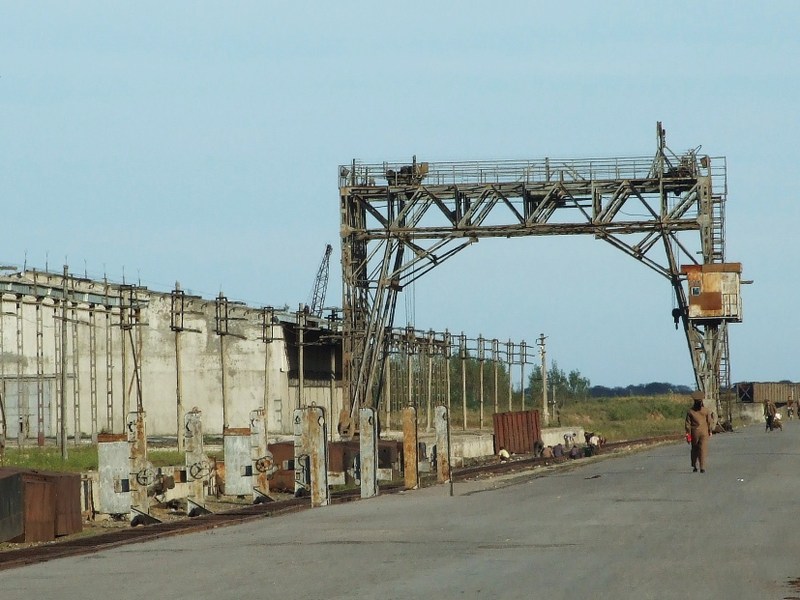
We returned to our sleeping-car. A building next to it:
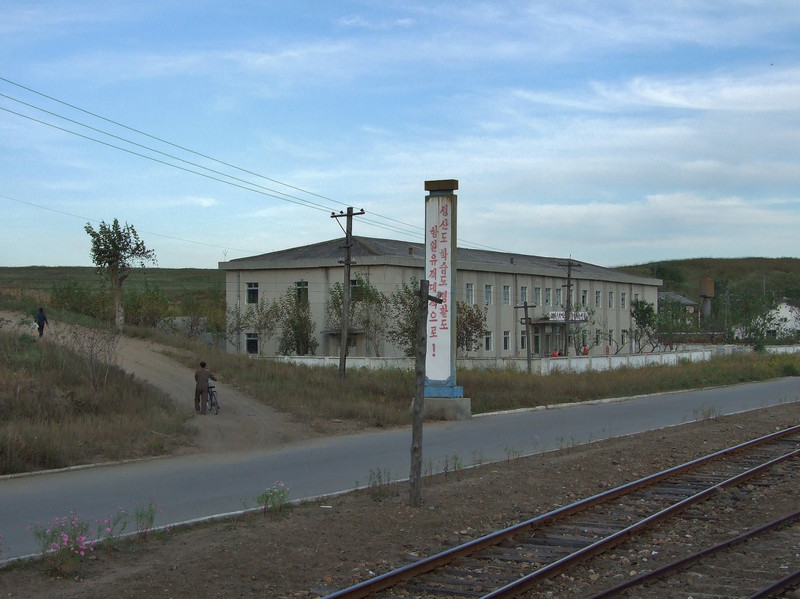
Finally, at about 18:15, train no. 7 from Pyongyang arrived. It was quite long:
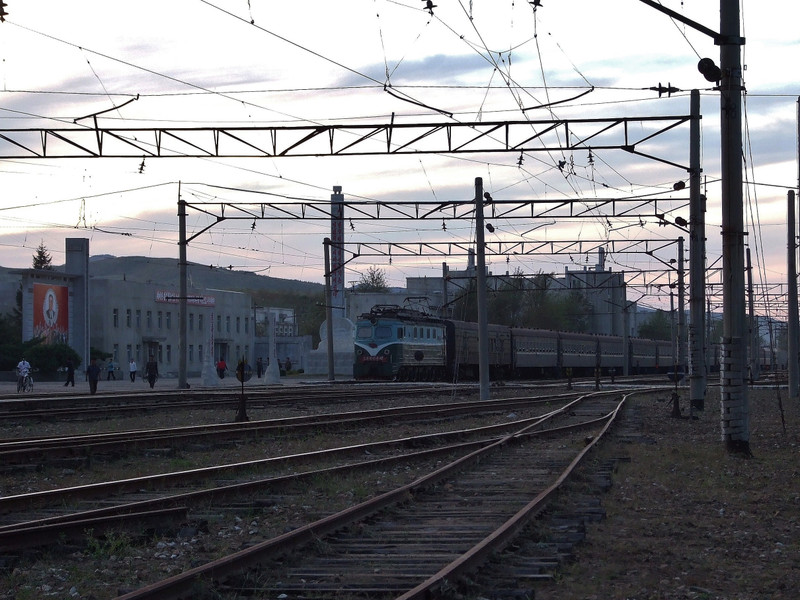
The Chinese diesel locomotive came again and our sleeping car was then attached to the Pyongyang-bound end of the train.
During the shunting maneuver:
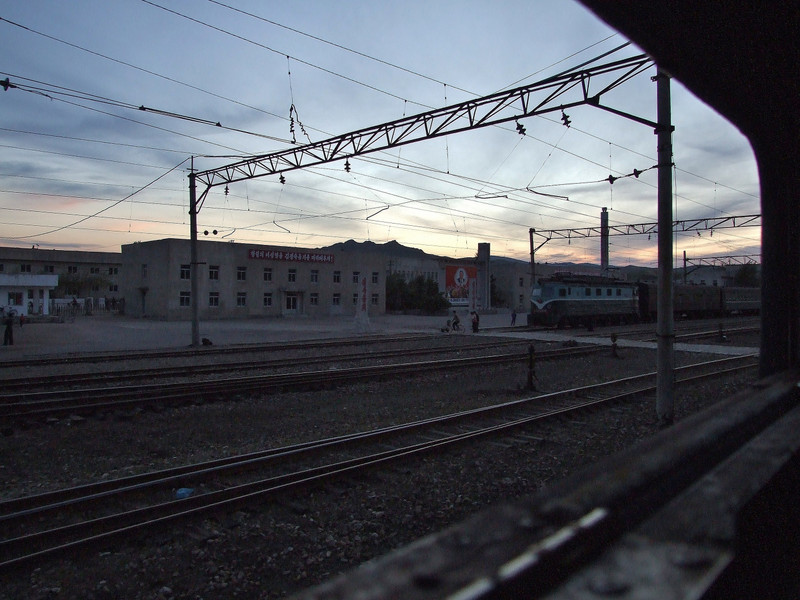
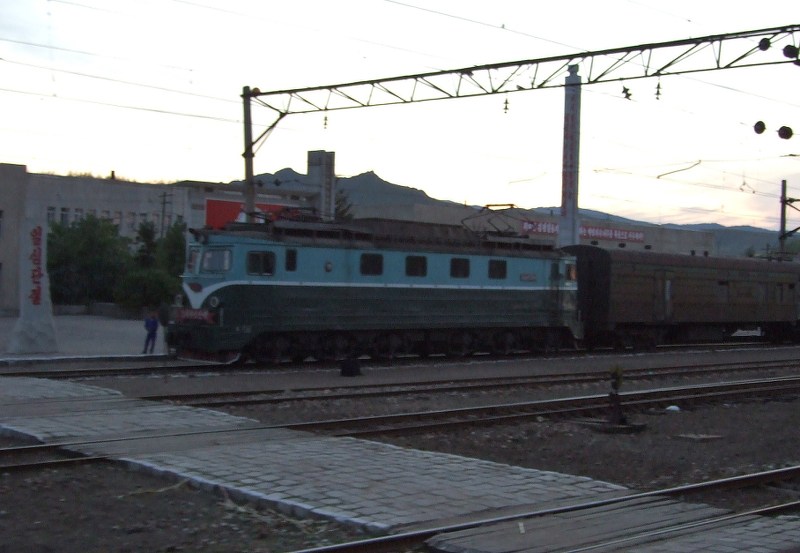
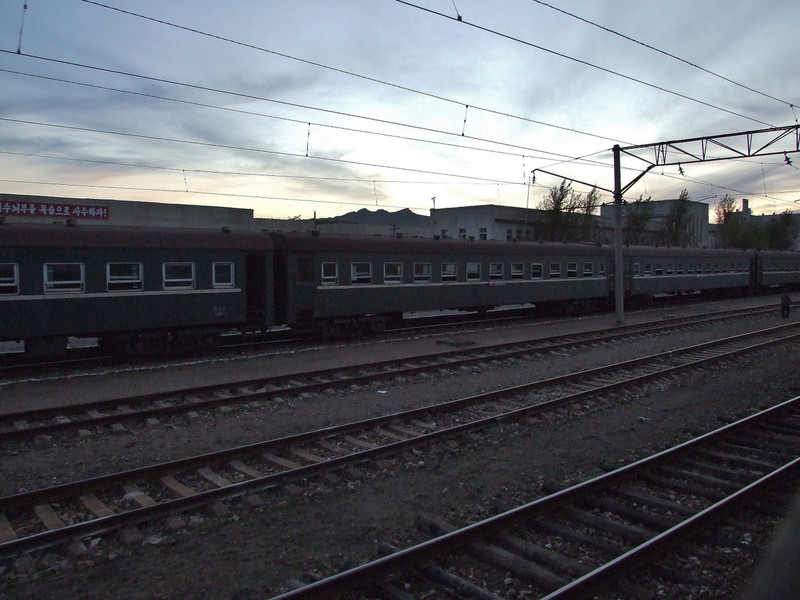
Please excuse the bad photo quality, but for the parts of my travelogue concerning North Korea I decided to publish also photos of inferior quality, if they show something interesting. I think that photos from this part of the world are quite rare and therefore I'd like to show as much photos as possible...
Most of the wagons were seating cars. There were two sleeping-cars and one seating car with two pantographs. Maybe it was some kind of buffet/dining car, but the window arrangement didn't differ from the other cars. Or maybe it was a special wagon, from which the other wagons are supplied with electrical power (instead of directly from the locomotive)?
Sunset at Tumangan:
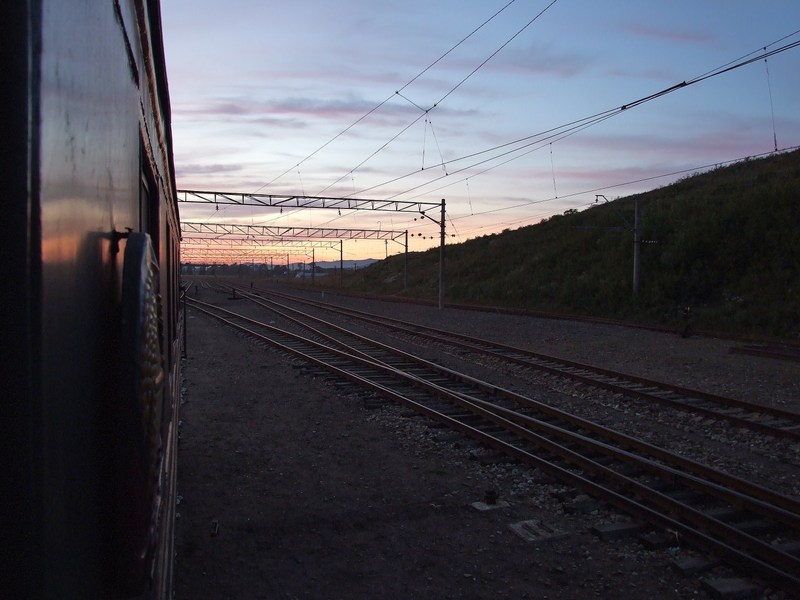
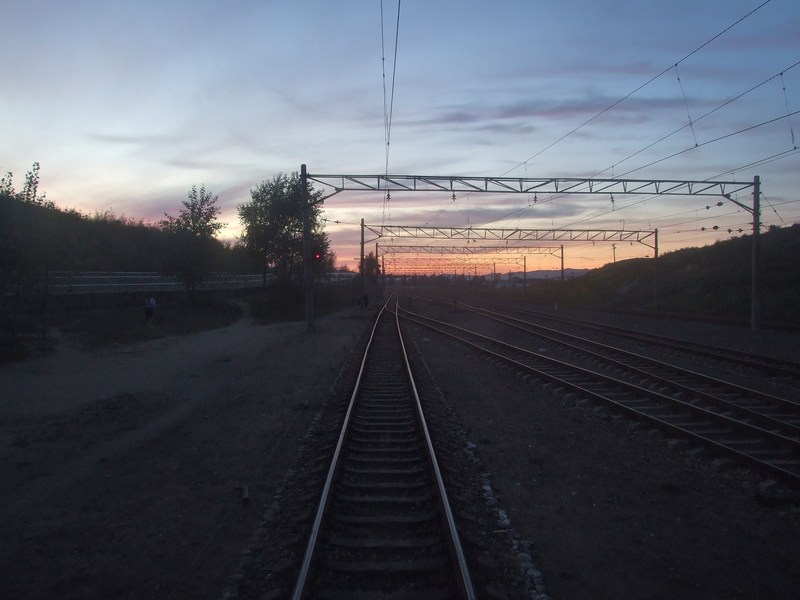
Later the electric locomotive together with two luggage cars was attached to the train. However, it seemed as there were technical problems with one of the luggage cars, so they had to put this wagon out of the train again.
So we still had some time to walk around at the platform. Meanwhile it was dark and there were no lights, the platform was in total darkness. There were quite many passengers boarding the train and also much railway staff commanding the passengers by blowing their whistles...
Finally, after some more whistling and after the train-horn sounded several times the train started moving towards Pyongyang at 20:00 – with two hours delay...
The sound of the train rumbling over the track with about 40 km/h is undescribable, the rail joints follow in very short intervals and the gaps between the rails seem to be quite big compared to other countries, which causes an unusual fast and loud "tatak-tatak" despite the low speed...
So we jingled through the dark night – the only lights outside are visible in the north, across the river in China...
That's the timetable for the further trip to Pyongyang according to the Russian railways:
+-----------------------------------+-----------+-----------+----------+
| station | arrival | departure | train |
+-----------------------------------+-----------+-----------+----------+
| Tumangan | 10:19 | 17:50 | 8 |
| Radzhin | 19:47 | 20:12 | |
| Chhondzhin | 23:20 | 23:52 | |
| Kilju | 03:58 | 04:10 | |
| Chamchin | 12:04 | 12:28 | |
| Kovon | 14:20 | 14:41 | |
| Pyongyang | 21:25 | | |
+-----------------------------------+-----------+-----------+----------+
We already assumed that this were not all the stops, and we were right...
After some kilometers we passed the triangular junction at which the line to Onsong – Namyang – Hoeryong branches off.
There were one or two stops untill we went to bed and it was always the same: Total darkness outside, people running around to find their wagon, other people loading stuff into the luggage-car, railway staff blowing their whistles and much "train-horning" before departure...
At some stop, when we were already sleeping, somebody was knocking on the door. We opened it and a soldier wanted to see our passports. After some minutes the passports were returned to us.
We were not really surprised about that, as we have heared that in North Korea there are also restrictions for North Korean citizen travelling inside their country. Especially travelling to Pyongyang is not easy for local people and requires a special permit. But here it was maybe the border of the Rajin-Songbon Economic Special Zone, which caused the additional passport check.
However, everything was OK and so we could continue sleeping...
----------------
Some more interesting information about the railway border Khasan/Tumangan:
At http://www.logistics.ru/9/7/i77_6557p0.htm you can find a Russian article about the history of this border crossing point.
The line on the Russian side from Baranovskiy to Khasan was built between 1938 and 1951. The first bridge over the border was a wooden railway bridge opened in 1952. In 1954, when cross-border freight traffic offically started, 4400 tons of freight were transported over the border. That number rose to 12.000 tons in 1955.
In 1959 the new bridge, which still exists today, was opened.
The peak in freight traffic was in 1988 with 4.795.000 tons (USSR > DPRK: 4.070.000 tons, DPRK > USSR 725.000 tons). The numbers show, that the USSR ecenomically supported the DPRK and due to the political and economical changes in the former USSR the mostly unidirectional trade between the two countries decreased after 1988:
1988 – 4.795.000
1990 – 3.526.000
1993 – 2.306.000
1994 – 761.000
1999 – 230.000
2002 – 68.000
Only after 2002 a slight increase is noticeable, in 2004 106.000 tons were transported. However, the infrastrucuture was overdimensioned, and it has therefore been reduced: Several tracks at Khasan station were removed, as well as 3 of 14 passing-tracks between Baranovskiy and Khasan.
Passenger traffic was opened in 1958 and 10582 passengers crossed the border during the first year. Till 1988 this number rose to 21.000/42.000 passengers (I'm not sure, does "vozroslo na 200%" mean "rose to 200%" or "rose by 200%"?).
The new station building in Khasan was opened in 1989 and it was suitable to handle up to 500 international passengers per day. However, also passenger traffic is now lower than it was at it's best times. During the 1st 6 months of 2005 5315 passengers crossed the border.
Nowadays Russian railways (RZD) have big plans for this border crossing point. One the one hand RZD hopes that the border between North and South Korea will be opened soon and that they can establish an transcontinental freight corridor from South Korea via Russia to Europe…
This might maybe not happen in the near future, but on the other hand RZD now under a joint-venture with North Korea rebuilds the line from Tumangan to the port of Rajin, where a new container terminal will be built. This line is 54 km long and in future it will be a dual-gauge line. From Rajin RZD and their partners want to establish a container-link by ship to Pusan in South Korea.
The ceremonies to mark the start of the reconstruction works were held on 4th october 2008 at Tumangan – just 2 weeks after us...
Read more:
http://www.railwaygazette.com/news_view/article/2008/10/8933/trans_korean_reconstruction_begins.html (english)
http://gudok.ru/index.php/63875 (Russian)
http://www.ptr-vlad.ru/news/ptrnews/7484-nachalas-modernizacija-zheleznodorozhnogo-puti.html (in Russian, with a TV-report)
http://www.amurpravda.ru/articles/2008/10/09/12.html ("6 hours in North Korea"; a Russian journalist writes about this personal impresssions of his visit to Tumangan)
For me it was quite strange to see a TV-report from Tumangan (my Firefox doesn't show the report for some unknown reason, IE does however) just two weeks after I have been there myself. And also in the TV-report the journalist notices the empty tracks at Tumangan...
Continue
----------------
DISCLAIMER
Alltough we succesfully entered North Korea via Tumangan, we were later via e-mail told by our travel agency, that our trip caused serious troubles at KITC (the governmental "Korean International Tourist Company").
I can therefore - untill KITC officially accepts this border point for tourists - not recommend to repeat what we did, as trying to do so might end up with another result...
----------------
YOU ALSO WANT TO TRAVEL EUROPE - PYONGYANG BY TRAIN?
Now there is also a travel agency, which can even organize Europe - Pyongyang train trips (but not the route we took). Also I recently found out that theoretically there is a possibility to travel to Rajin via Tumangan legally (but not to Pyongyang).
Click here for more information.
MY OTHER TRIPS
Eurasia 2005: ~35.000 km by train from Europe via Ukraine, Russia and Mongolia to China and back to Europe via Kazakhstan and Uzbekistan:
http://eurasia2005.blogspot.com/
Total solar eclipse 2008: Trip to the total solar eclipse in the Altay mountains (1st august 2008), including a 6-day trekking trip:
http://zatmenie2008.blogspot.com/
